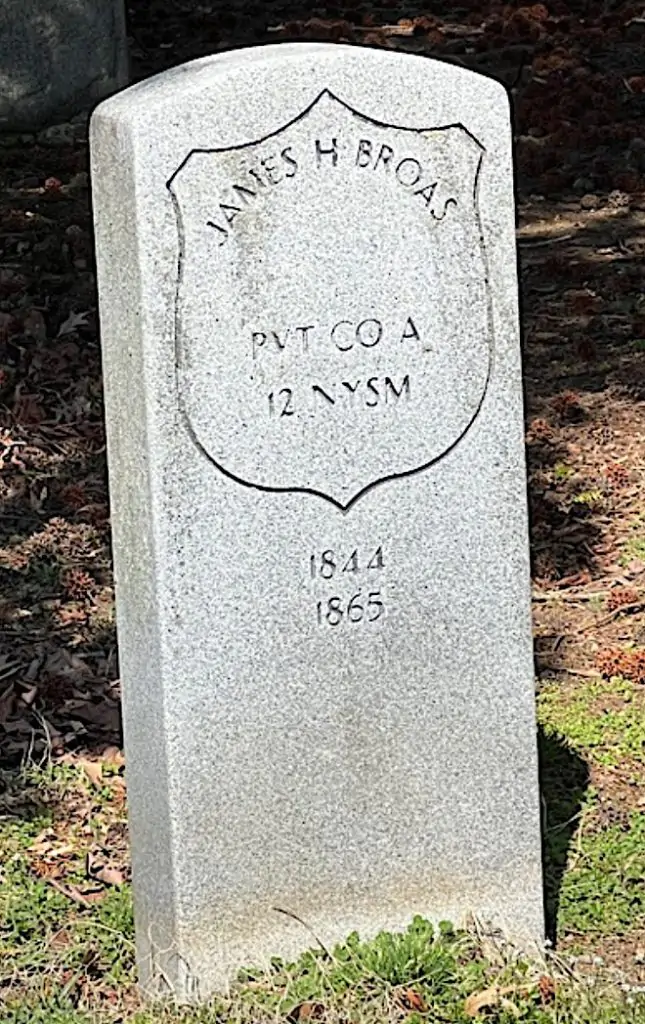BOETTNER (or BATTNER, BOETNER), GUSTAVE (or GUSTAV) A. (1843-1907). Private, Captain Kowald’s Independent Illinois Volunteers; sergeant, 134th Illinois Infantry, Company I. A resident of Chicago, Boettner first served in a company of Captain Kowald’s Independent Illinois Volunteers for three months in 1861. Subsequently, he re-enlisted as a private on May 11, 1864, mustered into the 134th Illinois on May 31, was promoted to sergeant at some point, and mustered out after 100 days on October 25 at Chicago.
Civil War Bio Search

1890 Brooklyn Directory. He may have been the George Boetner, a Brooklyn resident, listed on the 1890 Veterans Schedule who was shot through the body and spent four months in Andersonville Prison in Georgia. In 1890, the census listed him as a cycle machinist. The Brooklyn Directories for 1892-1894 and 1894-1896 list him as a painter; he then lived at 462 Sixth Avenue. According to the Brooklyn Directory for 1896-1898, he was a painter who lived at 368 13th Street. In 1907, his application for an invalid pension was granted, certificate 1,134,134.
As per his obituary in the Brooklyn Daily Eagle, he was a member of Thatford Post #3 of the G.A.R. and his widow, Jessie Boettner, was a member of the Rankin Woman’s Relief Corps of Rankin Post #10 of the G.A.R. Members of those organizations were invited to attend his funeral. Boettner died from cancer. He last resided at 498½ Sixth Avenue in Brooklyn. His funeral was held at the Sixth Avenue Methodist Episcopal Church. Jessie Boettner applied for and received a widow’s pension, certificate 677,216. Section 133, lot 16874, grave 93.
BOGARDUS, ROBERT (1834-1889). Private, 95th New York Infantry, Company A. A native of New York, Bogardus was a dentist according to the 1860 census. He enlisted as a private at Norwich, New York, on August 27, 1864, the same date that he mustered into the 95th New York. Subsequent to being taken as a prisoner of war at the Battle of Poplar Springs Church, Virginia, on October 1, 1864, he was paroled back to Union forces on an unknown date, and was discharged on May 31, 1865, at Washington, D.C.
As per the Brooklyn Directories for 1865, 1866, 1868, and 1870-1873, Bogardus was a dentist; all of his offices were at various addresses on Fulton Street; in the last directory, he lived at 105 North Oxford Street. Census records indicate that Bogardus was practicing his profession in 1880; he is listed as a dentist on Fulton Street in the 1880-1882 and 1888-1889 Brooklyn Directories. He last lived at 179 Hancock Street in Brooklyn. His cause of death was pneumonia. Section 190, lot 26594.
BOGART (or BOGERT, BOGEART), ADRIAN (1835-1922). Corporal, 158th New York Infantry, Company I; private, 84th New York (14th Brooklyn) Infantry, Company A. A New Yorker by birth and a resident of the New Utrecht section of Brooklyn, he enlisted as a private at Brooklyn on April 18, 1861, mustered into the 14th on May 23, and deserted on September 19 of that year at Arlington, Virginia. On September 3, 1862, Bogart re-enlisted at Brooklyn as a wagoner and mustered immediately into Company I of the 158th New York. He was promoted to corporal on May 10, 1865, and mustered out on June 30, 1865, at Richmond, Virginia.
After the Civil War, census records indicate that Bogart was employed as a carpenter. In 1891, his application for an invalid pension was approved, certificate 665,406. He is listed as a carpenter in the Brooklyn Directories for 1894-1896 and 1896-1898. He last lived on Bay 35th Street in Brooklyn. His death was attributed to heart disease. Section 4, lot 35271, grave 2.
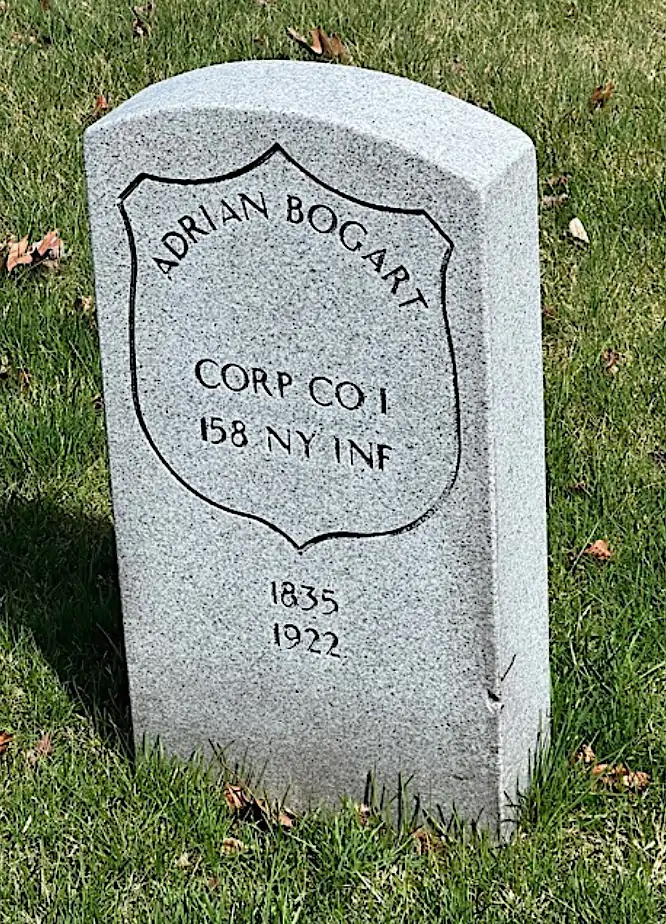
BOGART, A. SCHUYLER (1840-1862). Second lieutenant, 65th New York Infantry, Company I. Born in New York City and a resident of Brooklyn, he enlisted at New York City as a second lieutenant on September 3, 1861, and was immediately commissioned into the 65th New York Infantry, also known as the 1st U.S. Chasseurs. The 65th served under General McClellan in the Peninsula Campaign. Bogart was wounded in the knee at the Battle of Fair Oaks, Virginia, on June 2, 1862, was sent to New York on June 7, and succumbed to his wounds on June 23. His biography is listed in William Swinton’s History of the Seventh Regiment (1870); it is not known when he served in Company G. In 1883, his mother, Elizabeth Bogart, applied for and received a pension, certificate 214,245. Section 30, lot 10665.
BOGART, JOHN (1832-1893). Private, 5th Independent Battery, New York Light Artillery. A Brooklynite by birth, Bogart enlisted there as a private on November 10, 1862, and mustered that day into the New York Light Artillery. He mustered out on July 6, 1865, at Hart’s Island in New York Harbor. Although he applied for an invalid pension in 1889, application 726,129, it was never certified. He last lived on Fulton Street in Brooklyn. His wife applied for and received a widow’s pension, certificate 398,011. Section 15, lot 7890, grave 5.
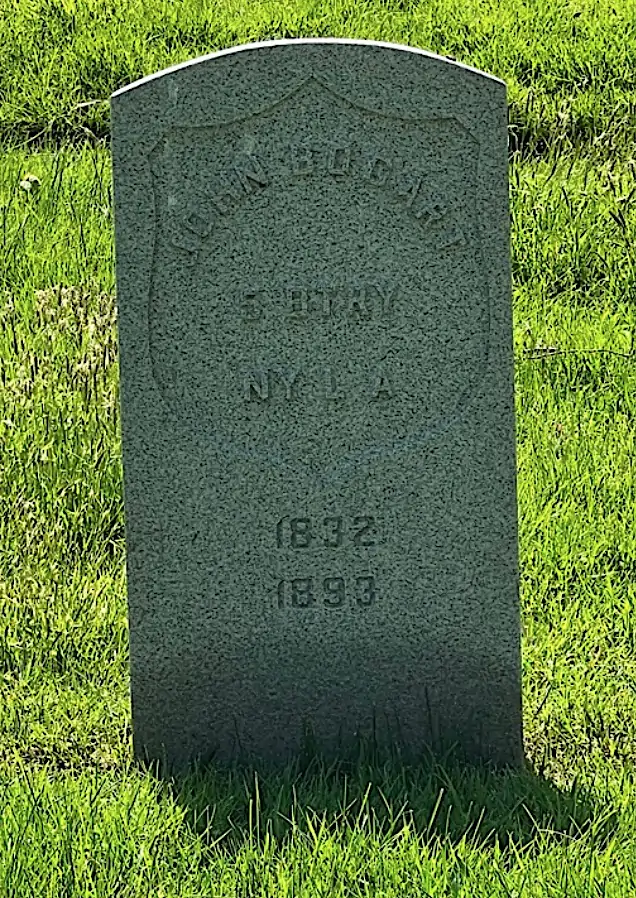
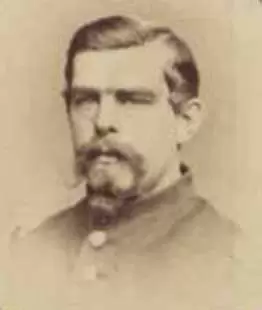
BOGART (or BOGERT), JOHN A. (1839-1870). Lieutenant colonel, 103rd United States Colored Troops (USCT); captain, 127th New York Infantry, Companies B and H; corporal, 9th New York Infantry, Company B. After enlisting at New York City as a corporal on April 23, 1861, Bogart, a native of the city, mustered into the 9th New York on May 4, and was discharged for promotion on August 31, 1862. The next day, he was commissioned into Company B of the 127th New York as a first lieutenant. He was promoted to captain on December 27, 1862, and transferred to Company H on May 1, 1863. Bogart was commissioned into the Field and Staff, 103rd USCT Infantry, promoted to lieutenant colonel on February 28, 1865, and mustered out on April 15, 1866. His name is displayed on the African American Civil War Memorial in Washington, D.C., plaque C-102. Bogart last lived at 68 Bank Street in Manhattan. He died from Bright’s disease. Section 105, lot 4814.
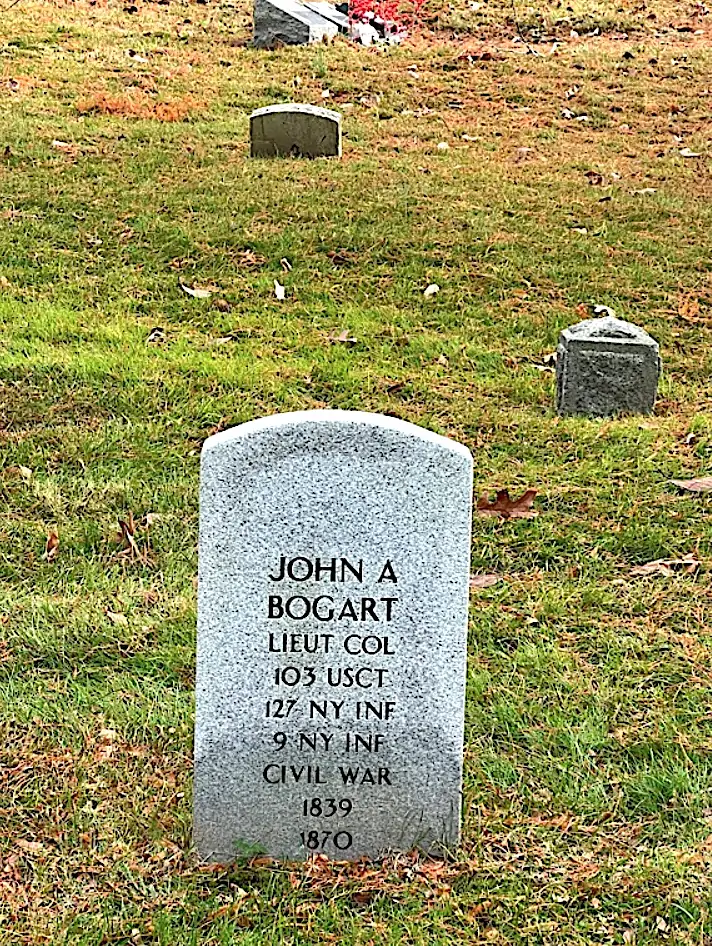

BOGART, WILLIAM H. (1843-1896). Private, 22nd Regiment, New York State National Guard, Company B. A native New Yorker who was employed as a clerk, he enlisted at New York City as a private on May 28, 1862, mustered in the same day, and mustered out at New York City after three months on September 5.
According to the 1880 census, Bogart was a detective. His last residence was 88 Lexington Avenue in Manhattan. His death was caused by tuberculosis. Jennie Bogart, who is interred with him, applied for and was granted a widow’s pension in 1897, certificate 458,885. Section 83, lot 2572, grave 13.
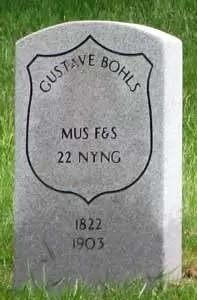
BOHLS, GUSTAVE (or GUSTAV) (1822-1903). Musician, 22nd Regiment, New York State National Guard. Bohls, who was born in Germany, served for 30 days in the 22nd Regiment in 1863. He entered as a band member, was assigned to the Field and Staff, and was promoted to the rank of musician during his service. In civilian life, he was employed as a musician. Bohls last lived in New York where he died from pneumonia. Section 202, lot 28093, grave 1.
BOHNLOFINK (or BOHNLAFINK), SAMUEL (1830-1899). Saddler, 18th New York Cavalry, Company K; private, 14th New York Cavalry, Company F; 156th New York Infantry, Company G. Born in Saxon, Germany, and 5’8″ tall, Bohnlofink came to the United States in 1859. After enlisting as a private at LeRoy, New York, on February 17, 1863, he mustered into Company F of the 14th New York Cavalry on February 26, and transferred at some point to Company B before he left that regiment. On June 24, 1863, he transferred into the 156th New York where he served until he was promoted to saddler on June 12, 1865, effective upon his transfer into the 18th New York Cavalry’s Company K that day.
Twice wounded during the War, Bohnlofink was thrown from his horse during a battle in Louisiana when the horse was killed by a shell and then wounded in the left shoulder by a saber in a cavalry battle on December 25, 1864, in Mobile, Alabama. He became a saddler sergeant on November 22, 1865, before he mustered out on January 10, 1866, at San Antonio, Texas. His descendants have a Civil War medal of his with the inscription that he was a sergeant but the date of that promotion is not known.
His application for an invalid pension was granted in 1876, certificate 641,957. In civilian life, he was a brick mason. He last lived at 399 Warren Street in Brooklyn. He died from pneumonia. Section C, lot 36418.
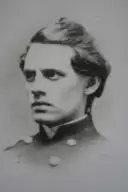
BOHRINGER, JOHN (1831-1902). Second lieutenant, 28th New York Infantry, Company F. Of German birth, Bohringer became a naturalized citizen in 1850. He first served as a sergeant from April 23, 1861, through August 5, 1861, in the 28th Regiment. He re-enlisted at Brooklyn as a second lieutenant on June 16, 1863, was commissioned into the 28th National Guard that day, and mustered out at Brooklyn on July 22, 1863.
Employed in the beer business according to the 1870 census, Bohringer was a saloon-keeper by 1880, and was working in the liquor business at 311 Atlantic Avenue as listed in the Brooklyn Directory for 1888-1890. In 1884, he applied for and was granted an invalid pension, certificate 335,942. The 1890 Veterans Schedule confirms his two enlistments in the 28th New York. The Brooklyn Directories for 1894-1896 and 1896-1898 continue to list him as working in the liquor business at 311 Atlantic Avenue. He was in Long Island at the time of his death from paresis, but had been residing in Brooklyn. Section 136, lot 28070, grave 55.
BOICE, FRANK (1832-1918). Assistant engineer, Union transport ship. Boice, who was born in Barrytown in Dutchess County, New York, was a farmer in his youth. According to his obituary in the Brooklyn Standard Union, he was an assistant engineer on one of the Union transport ships during the Civil War. There are no further details about that service. Later, he was employed as a fireman in the engine rooms of the Catherine Street Ferry. His last residence was 1335 South Curtis Avenue, Morris Park, New York, where he died from heart disease. Section 129, lot 27373, grave 17.
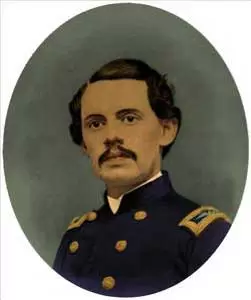
BOKEE, JR., DAVID ALEXANDER (1840-1884). Colonel, 28th Regiment, New York State National Guard; first lieutenant and adjutant, 132nd New York Infantry. Born in Brooklyn, Bokee enlisted there as an adjutant on April 23, 1861, mustered into the 28th New York State Militia the next month on May 11, and mustered out at Brooklyn on August 5. On August 7, 1862, he re-enlisted at Albany, New York, as a first lieutenant, was promoted that same day to first lieutenant and adjutant, was commissioned into the 132nd New York a week later, and was discharged on December 20 of that year because he was sick and unfit for duty. He re-joined the 28th Regiment (then part of the National Guard) as lieutenant colonel on June 16, 1863, served 30 days and mustered out on July 22. Promoted to colonel on September 1, 1864, he served 100 days with the 28th in 1864.
Bokee was employed as a clerk in Brooklyn after the war. In 1866, he married Mary Ellen Boynton; the couple had four children. He is likely the David A. Bokee listed as working in coal in the 1880-1882 Brooklyn Directory; he then lived at 803 Lincoln Place. His father, David Alexander Bokee Sr., served as a United States Congressman. He last resided at 62 St. John’s Place in Brooklyn where he succumbed to heart disease. Section 119, lot 133.
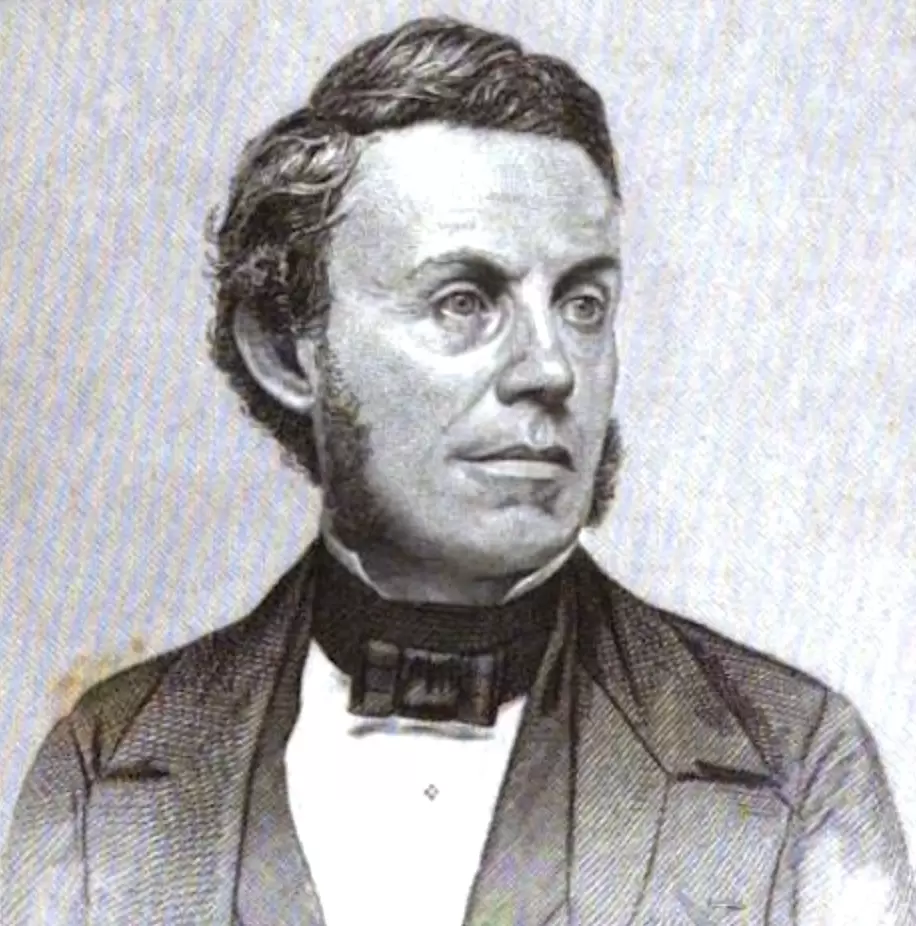
BOLANDER, GEORGE A. (1845-1878). Private, 13th Regiment, New York State National Guard, Company F. A Brooklynite by birth, Bolander enlisted there as a private in 1863. He mustered into the 13th Regiment for its activation of 30 days and mustered out when his enlistment was up. He was likely a relative of William Bolander (see). His last address was 147 Harrison Street in Brooklyn. His death was attributed to Bright’s disease. Section 93, lot 2202.
BOLANDER, WILLIAM HENRY (1838-1913). Private, 13th Regiment, New York State National Guard, Company E. After enlisting at Brooklyn, his place of birth, on May 28, 1862, Bolander immediately mustered into the 13th, and mustered out there after three months of service on September 12. A clerk in 1880 and an agent as per the Brooklyn Directory for 1885-1886, he was subsequently employed as a railroad agent according to the 1900 census. He joined the Lafayette Post #140 of the G.A.R. in 1900. In 1904, he applied for and received an invalid pension, certificate 1,096,804. As per his obituary in the New York Herald, he was a Freemason; comrades from his lodge were invited to attend his funeral. Another notice of his death in the New York Herald requested members of the Lafayette Post, of which he was a past commander, to attend his funeral in uniform or civilian dress with a badge. He was likely a relative of George Bolander (see). His cause of death was an embolism. He last resided at 347 West 123rd Street in Manhattan. Jennie Bolander, who is interred with him, applied for and received a widow’s pension in 1913, certificate 769,020. Section 93, lot 2202.
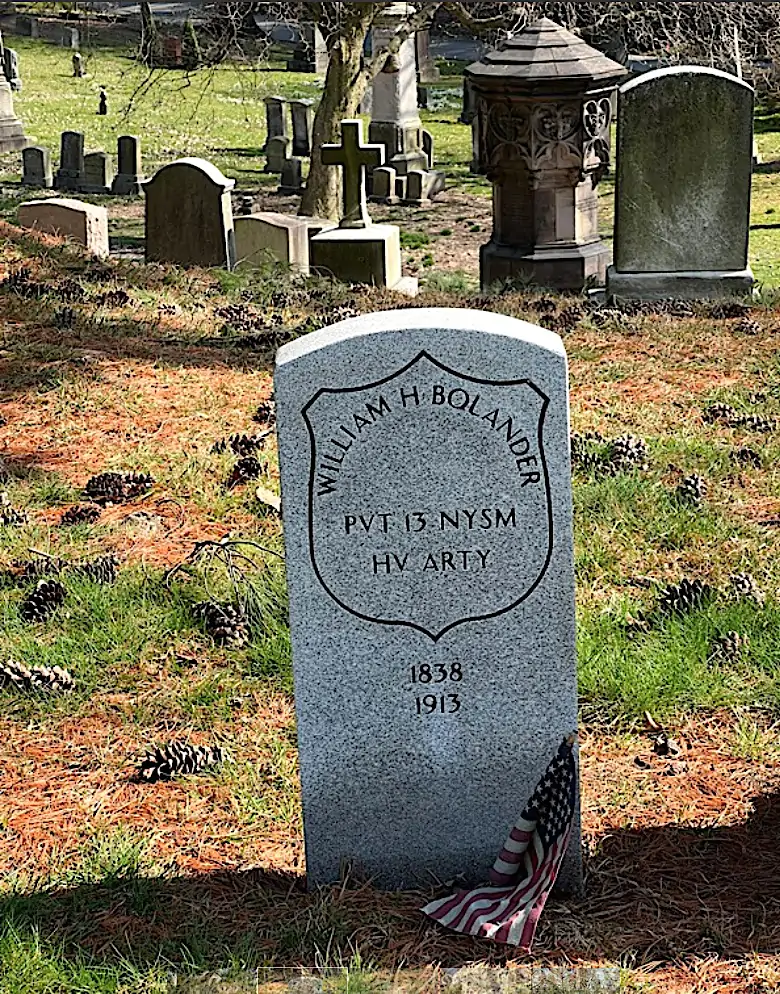
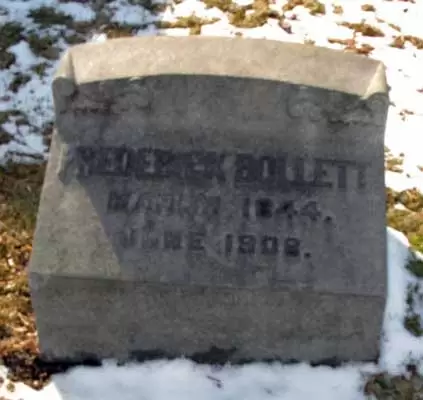
BOLLETT (or BOLLET), FREDERICK H. (1844-1908). Private, 5th New York Infantry, Company H. Bollett enlisted at New York City on April 23, 1861, and mustered into the 5th on May 9. A carriage-maker by trade, he was 6′ 1½” with blue eyes and light brown hair. Bollett was wounded in the left leg at Second Bull Run, Virginia, on August 30, 1862, captured that day, and paroled three days later. After being hospitalized in Alexandria, Virginia, and given sick leave, he returned to duty on April 8, 1863, and mustered out with his company at New York City a month later on May 14.
A member of the 5th Veterans Association after the Civil War, Bollett was employed as the superintendent of a livery stable on Chrystie Street in Manhattan, and as an insurance salesman. In 1873, he applied for and was granted an invalid pension. Bollett is listed as being in the livery business at 470 Grand Avenue in the Brooklyn Directory for 1894-1896; at that time, he lived at 856 Dean Street. He lived at 572 Classon Avenue in Brooklyn at the time of his death from apoplexy. His widow, Mary Bollett, applied for and received a pension in 1908, certificate 657,363. Section 202, lot 32880.
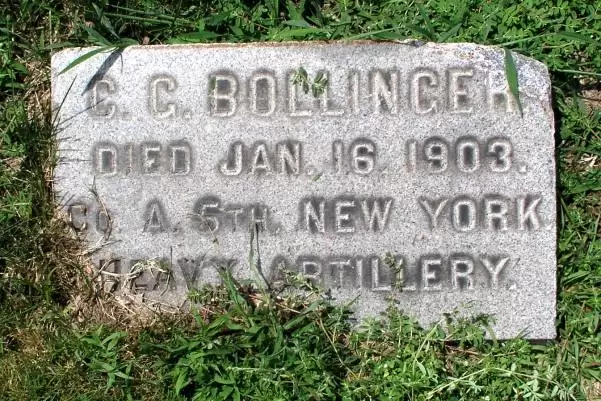
BOLLINGER, CHRISTOPHER (or CHARLES) G. (1841-1903). Sergeant, 5th New York Heavy Artillery, Company L (although his gravestone says Company A). Bollinger, also known as Charles, was born in Holland. He enlisted as a private on March 25, 1864, mustering into the 5th New York Heavy Artillery. He was promoted to sergeant on June 6, 1865, and mustered out on July 19, 1865, at Harpers Ferry, West Virginia.
According to the 1880 census, Bollinger was employed as a printer. In 1885, his application for an invalid pension was approved, certificate 412,519. In 1890 and 1900, he was living in the District of Columbia where he worked as a plate-printer. He died from “rheumatism of the left side” in Washington, D.C. Catherine Bollinger, who is interred with him, applied for and was granted a widow’s pension in 1903, certificate 549,793. Section 5, lot 13218, grave 3.

BOLSTER, GEORGE WASHINGTON (1834-1891). First lieutenant, 37th New York Infantry, Company B. A native New Yorker, his father, Henry Bolster, was active in the Whig Party and became wealthy after founding a stage coach/omnibus business. Bolster enlisted at New York City as a second lieutenant on May 29, 1862, was commissioned into 37th New York on that day, and mustered out at New York City on September 2, 1862. On May 6, 1864, he was commissioned into the same regiment and company as a first lieutenant, mustering out on June 6 of that year at Staten Island.
In 1875, he was living in Kansas and worked as a farmer. He returned to New York where the 1880 census showed that he was an omnibus clerk. The Veterans Schedule for 1890 confirms his military history. As per his obituary in the New York Herald, comrades from his Masonic lodges and Knights Templar lodge were asked to attend his funeral in citizen dress. His last residence was at 82 East 77th Street in Manhattan. Bolster’s cause of death was pneumonia. His funeral was held at the St. Luke’s Methodist Episcopal Church on West 41st Street and Sixth Avenue. Newspapers in Jacksonville, Florida, and Fort Scott, Kansas, were asked to print notices of his death. Section 105, lot 2911.

BOLTON, JOHN (1838-1911). Sergeant, 79th New York Infantry, Company I; corporal, 82nd New York Infantry, Company E. Born in Ireland, he immigrated to the United States in 1854. Bolton enlisted at New York City on April 18, 1861, and mustered into the 82nd on May 21. Although his soldier record indicates that he deserted on August 2, 1861, at Washington, D.C., his pension record indicates that he was discharged on May 30, 1864. The pension record also indicates service in the 79th New York. According to the pension index cards, he enlisted as a sergeant on May 13, 1861, mustered into the 79th on May 27, rose to first sergeant at some point, and was discharged at New York on May 31, 1864. However, he could not have served in both regiments simultaneously.
The 1880 and 1900 censuses indicate that Bolton was employed as a traveling salesman. At the time of the 1890 Veterans Schedule, he was living at 692 10th Street in Brooklyn, the same address as in the next two censuses. In 1907, he received a pension, certificate 1,143,021. Bolton died from nephritis. Section 202, lot 28639, graves 1 and 2.
BOMHARD (or BONEHARDTT, BAUMHARDT, BOMHARDT), JOHN (1828-1911). Private, 119th New York Infantry, Company G. Of German origin, he enlisted at New York City as a private on August 18, 1862, mustered into the 119th New York on September 5, and mustered out on June 7, 1865, at Bladensburg, Maryland. His application for an invalid pension was granted in 1890, certificate 585,821. He last lived at 81 Poplar Street, Brooklyn. Bomhard’s cause of death was pneumonia. Section 136, lot 28307, grave 705.
BOND, CHARLES A. (1832-1888). Private, New York Enfans Perdus, Company E. Bond enlisted as a private at New York City on March 21, 1862, and mustered immediately in Company E of the New York Enfans Perdus. He was discharged for disability on August 9, 1862, at Yorktown, Virginia. His pension index also indicates service in Company A of the 8th New York but gives no details. Although he applied for an invalid pension in 1887, application 632,091, he died from tuberculosis before it was approved. He last lived at 2155 8th Avenue in New York City. Julia Bond, who is interred with him, applied for and received a widow’s pension in 1888, certificate 598,567. Section 15, lot 17263, grave 682.
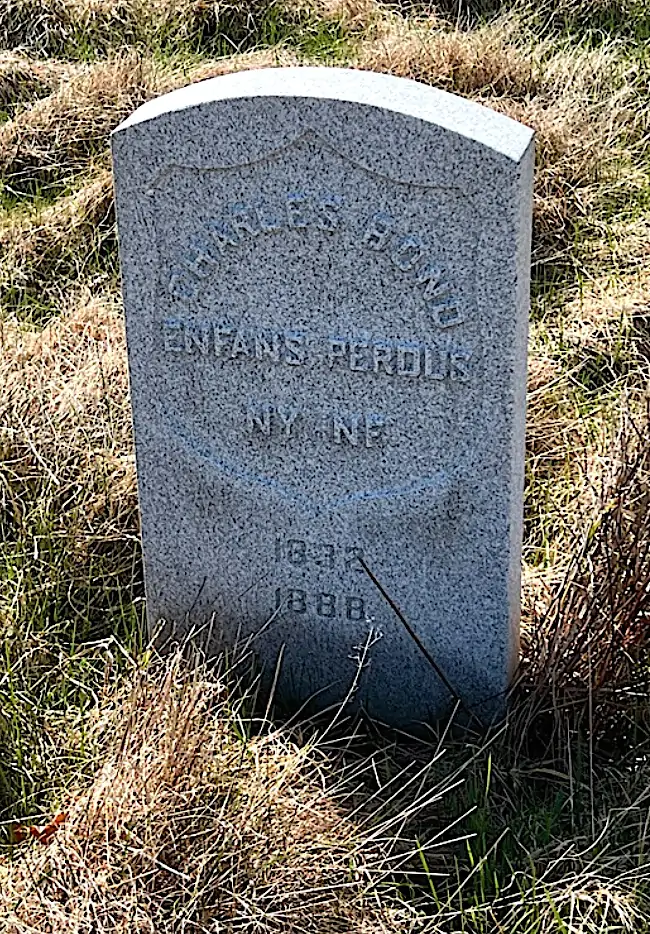

BOND, LORENZO (1838-1914). Sergeant, 48th New York Infantry, Company B. A native of Brooklyn who was employed as an accountant, he enlisted there as a private on September 4, 1861, and mustered into the 48th New York the next day. During his service, he was promoted to corporal at some point, wounded at Fort Wagner, South Carolina, on July 18, 1863, promoted to sergeant on November 9, 1863, reduced to corporal six days later, and discharged on September 20, 1864.
After the war, Bond was a book dealer according the 1870 census and worked as a bookkeeper according to the censuses of 1880 and 1900. In 1884, he filed for and received an invalid pension, certificate 320,267. He lived at the Brooklyn Home for the Aged the last ten years of his life. He died from pyelitis (bacterial infection of the kidneys). Section 189, lot 16591, grave 7.
BONFIELD, ALFRED RUSSELL (1840-1912). Sergeant, 3rd Regiment, New York State Militia (Cavalry), Companies D and I; 56th Regiment, New York State National Guard, Company A. A native of England, he enlisted as a private and served in Companies D and I of the 3rd New York State Militia for three months in 1861. Additional details of this service are unknown. In 1863, he re-enlisted as a sergeant for a tour of 30 days and mustered into Company A of the 56th Regiment.
In 1907, Bonfield applied for and received a pension, certificate 1,152,547. His last residence was at 1961 Dean Street, Brooklyn. Originally interred in Prospect Cemetery in Jamaica, Queens, after his death from nephritis on July 26, 1912, he was re-interred at Green-Wood on November 22 of that same year. Section 115, lot 20900, grave 1.
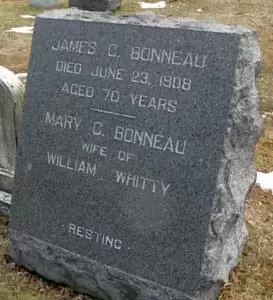
BONNEAU, JAMES C. (1838-1908). Private, 8th Regiment, New York State National Guard, Company C. Bonneau enlisted at New York City on May 29, 1862, mustered into the 8th Regiment on that date, and mustered out on September 10, 1862, at New York City. In 1896, his application for an invalid pension was approved, certificate 937,893. His last residence was 80 Thomas Street in Newark. His death was attributed to complications of alcoholism. Section 163, lot 14479, grave 12.
BONNER, ROBERT (1827-1896). Private, 119th New York Volunteer Infantry, Company A; 18th Veteran Reserve Corps, Company I. A native of Ireland, Bonner enlisted at New York City on August 7, 1862, and mustered into the 119th New York on September 4. According to his pension record, he also served in Company B of the 119th Regiment. On March 15, 1864, he transferred into the 18th Veteran Reserve Corps from which he mustered out on June 29, 1865, at Washington, D.C.
Bonner was employed as a hatter, according to the 1880 census. In 1885, his application for an invalid pension was approved, certificate 325,877. He last resided in New York City. His death was attributed to tuberculosis. Section C, lot 20595, grave 3.
BOOCOCK (or BOCOCK), JOHN W. (1837-1867). First lieutenant, 82nd New York Infantry, Company C; second lieutenant, 19th Regiment, New York State National Guard, Company D. A native of New York, Boocock enlisted at New York City as a first lieutenant on May 21, 1861, mustered immediately into the 82nd Infantry and was discharged from military service on September 1, 1861, at New York City. On May 26, 1862, he re-enlisted as a second lieutenant at Newburgh, New York, served for three months with the 19th regiment, and was discharged on September 6, 1862, at Newburgh. His last residence was 362 Henry Street, Brooklyn. Section 90, lot 22539.
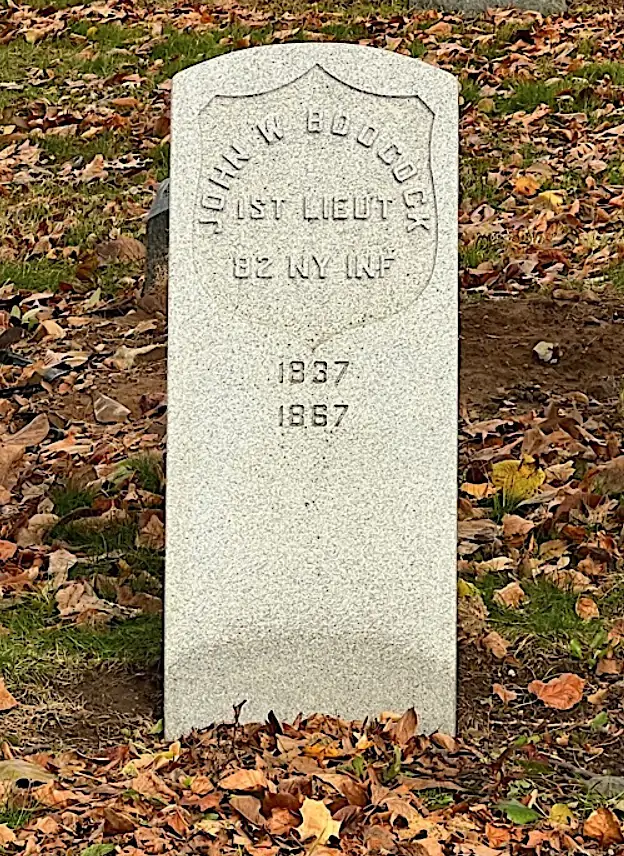

BOOCOCK, SAMUEL W. (or D.) (1837-1926). Private, 13th Regiment, New York State Militia, Company G. A native of Brooklyn, Boocock served with the 13th New York State Militia for three months in 1861. A prominent stock broker, he is listed in the Brooklyn Directory for 1868 and as having his office at 30 Broad Street in the New York City Directories for 1875-1876 and 1877; he lived at 97 Joralemon Street at the time of the 1877 Directory. He is also listed as a broker in the 1880 census, the Phillips Business Directory for 1881-1882, and in the Brooklyn Directories for 1885-1886 and for 1888-1889, his office was still at 30 Broad Street in Manhattan at that time. According to the 1890 and 1900 censuses, he was a banker. On May 16, 1892, the Brooklyn Daily Eagle listed Boocock as having a fortune of more than one million and among the richest men in Brooklyn.
An article in the May 10, 1916 edition of The New York Times stated that he was the guardian of his grandchildren, Anna and Kenyon, after his son, Howard Boocock who was also a banker, committed suicide after killing his wife, Adele Boocock, on March 24, 1915. Samuel Boocock received a sum of $3,500 for support of the children (out of the $223,750 held in a trust established by their father).
Boocock, a bond and stock broker, was the principal of his firm, S.W. Boocock & Company, which relocated to 25 Broad Street in Manhattan, and held a seat on the New York Stock Exchange for 57 years. He last lived at 87 Joralemon Street in Brooklyn and is buried in the same lot as Howard and Adele. At the time of his death from bladder cancer, his estate was valued at $5,445,966 ($66,000,000 in 2010 dollars). Section 10, lot 29731.
BOOKSTAVER, ALONZO M. (1846-1870). Private, 127th New York Infantry, Company A. After enlisting at New York City on August 12, 1862, he mustered in on September 8. Wounded in the Battle of Diascund Bridge, Virginia, on July 11, 1863, he mustered out on June 6, 1865, at Armory Square Hospital, Washington, D.C. He last lived at 30 Horatio Street in Manhattan. He died from cholera infantum. Section 91, lot 10277.

BOOROM (or BOEMAN), JARED D. (1827-1862). Gunner, United States Navy. Interred at Green-Wood on May 21, 1862, Boorom’s remains were removed from the cemetery on March 6, 1863, and re-interred at Green Hills Cemetery in Dryden, New York. He joined the Navy as a gunner on September 24, 1853, and was assigned to the St. Mary’s. On November 24, 1856, he was detached at Panama and then transferred to the Independence. After being assigned to a receiving ship in New York on January 1, 1857, he was detached to the San Jacinto on June 10, 1859.
During the Civil War, Boorom was assigned to the USS Galena, an ironclad that was built by the Union Navy. The Galena had an unusual armor-plating that proved ineffective. Commissioned on April 21, 1862, she was part of the North Atlantic Blockading Squadron off Fortress Monroe, Virginia. The Galena was then stationed on the James River and on May 15 was at Drewry’s Bluff, about eight miles from Richmond, Virginia, when Confederate fire perforated her armor and 13 men of her crew were killed and 11 wounded. As per the Navy surgeon’s report, Boorom incurred gunshot wounds to the posterior of his left foot and ankle joint. After about an hour, he began hemorrhaging profusely; a tourniquet was applied and he was given stimulants but he succumbed to his wounds the next day. The 13 dead were transferred from the Galena and moved ashore to Jamestown Island for initial interment. Boorom’s name was listed in Bodies In Transit, an account of the transportation of corpses into and out of New York City; he was interred at Green-Wood on May 21. He was ultimately interred in the Green Hill Cemetery in Dryden in Tompkins County, New York.
Manuelita Boorom, his widow, applied for and received a pension of $10 per month from the Navy as of October 27, 1863, certificate 167; she remarried in 1865. Boorom’s minor daughter, Nellie, began receiving her minor’s pension of $10 per month as of February 12, 1865, certificate 4,488; that pension was initially set to terminate in December of 1875. On May 15, 1890, Manuelita Zorilla Herbruger, his widow who remarried and lived in Panama, Republic of Colombia, testified that she was the mother of Nellie Augusta Boorom Vargas, born in Cortland, New York, in 1860. On January 8, 1891, Nellie Vargas informed the Pension Bureau that she had received the $1,498 in back pay and expected to receive $12 a month in the future.
BOOTH, SAMUEL (1818-1894). Brooklyn mayor, chairman of the Brooklyn Bounty Committee. Born in England, he immigrated with his parents to New York City as an infant. At the age of ten they moved to Brooklyn, where he lived for the rest of his life. At the age of fourteen he left school to become a clerk in a wholesale grocery business. After two years there, he apprenticed to a carpenter-builder and pursued that trade for the rest of his life. In 1851 he was elected alderman and was responsible for the erection of the Kings County Penitentiary. He was elected supervisor in 1857 and served as chairman of the committee for the erection of the County Court House and as chairman of the Bounty Committee during the Civil War. In all $3,800,000 was expended under his supervision to pay bounties to enlisting volunteers and to make payments to widows and orphans of soldiers. He served as mayor of the City of Brooklyn 1866-1867 and was appointed postmaster of Brooklyn in 1869. Section 66, lot 3840.
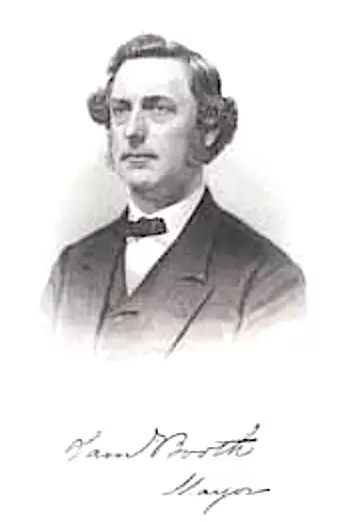
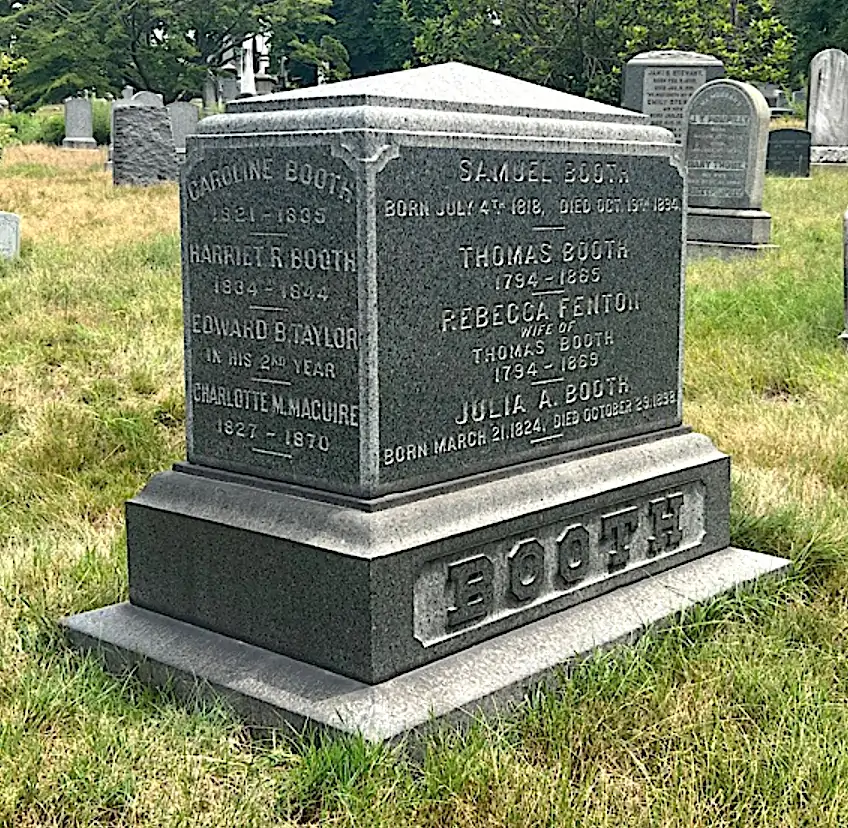
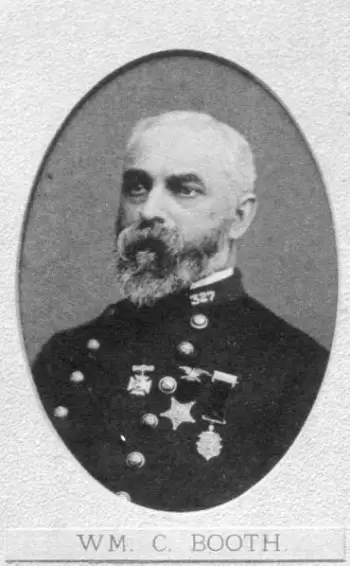
BOOTH, WILLIAM C. (1830-1910). Lieutenant colonel, 52nd Regiment, New York State National Guard; second lieutenant, 14th Regiment, New York State Militia, Companies A and I. A resident and native of Brooklyn, he was a carpenter and brother of Samuel Booth, an ex-mayor of Brooklyn. Prior to the Civil War, he was a member of Company A of the 14th New York State Militia, joining in 1850 and serving for 10 years. Enrolled as ordnance sergeant of Company A, 14th Regiment, New York State Militia, on April 18, 1861, he became second lieutenant on May 26. Soon after, he organized Companies I and K of the 14th Regiment and was elected captain of Company I. When he returned to the front, he learned that was not going to be commissioned captain, left the military, and served his country as a member of the Christian Commission, a voluntary position whose associates ministered to the sick.
Always ready for an emergency and quick to respond when duty called, Booth raised and organized a regiment in 1863, the 52nd Regiment, New York State National Guard, in 24 hours, and went with it to the front as its lieutenant colonel. He enlisted on June 14, was commissioned in five days later, and mustered out the next month at Brooklyn on July 25. Subsequently, he resumed his connection with the 14th Regiment serving as a first lieutenant until he resigned his commission in 1868.
Much respected by surviving veterans who served with him, they noted that Booth was “one of those who sprung to arms at the call of the Union, and by your conduct since have shown yourself tried and true, having warmed our hearts toward you by your untiring exertions and modest demeanor.” First affiliated with the William Rankin Post #10 of the G.A.R., he became a charter member of the Ulysses S. Grant Post #327 and continued his activities in local church affairs. A builder by trade, he superintended the construction of the Federal Building in Brooklyn. As per his obituary in the Brooklyn Daily Eagle, comrades from the Grant Post of the G.A.R. were requested to attend his funeral in uniform without side arms. His last residence was 258 Carlton Avenue, Brooklyn. He died from catarrh (inflammation of the mucous membranes). Section 66, lot 23136.
BORST, WILLIAM HENRY (1845-1882). Private, 61st New York Infantry, Company H. A New York native, Borst enlisted as a private at Green, New York, on March 7, 1864, and mustered into the 61st New York a day later. He was wounded at Spotsylvania Courthouse, Virginia, on May 8, 1864, and mustered out on July 14, 1865, at Alexandria, Virginia. At the time of his death from cancer, he lived at 93 Lexington Avenue in Manhattan. Section 68, lot 1312.
BOSCHEN, FREDERICK (1846-1902). Sailor, United States Navy. Born in New York City, he enlisted in the United States Navy during the Civil War. He served on the USS Hartford at the Battle of Fort Fisher, North Carolina, and in various other naval engagements during the conflict. After the War, he was employed as a manufacturing upholsterer and was a member of the Royal Arcanum and of the Chivalric Knights of St. John and Malta. He last resided at 17 Elton Street, Brooklyn. Boschen died from heart disease. Section 58, lot 1960.
BOSCOWEN (or BOSCAWEN), WILLIAM (1834-1896). Landsman, United States Navy. A native of New York City, Boscowen enlisted there on January 26, 1860, and enrolled in the Navy. He served aboard the USS Brooklyn and the USS Wabash and was discharged at Philadelphia, Pennsylvania, on October 10, 1861, when the vessel was taken out of commission. He was a member of the Henry M. Lee Post #21 of the G.A.R., joining in November of 1886. Boscawen received a pension from the Navy under certificate 21,808. He last lived at 595 Putnam Avenue in Brooklyn. His wife applied for and was awarded a widow’s pension, certificate 11,323. Section 12, lot 7845, grave 8.
BOSTWICK, EDWARD L. (1846-1933). Corporal, 1st New York Mounted Rifles, Company E; 4th New York Provisional Cavalry, Company E; drummer, 101st New York Infantry, Company D; private, 37th New York Infantry, Company H; 16th New York Heavy Artillery, Company B. Bostwick enlisted as a drummer at Hancock, New York, on October 27, 1861, and mustered into Company D of the 101st New York the same day. On December 24, 1862, he was transferred into Company H of the 37th New York with the rank of private. He was discharged on an unknown date. On January 6, 1864, he re-enlisted at Brooklyn as a private and mustered into the 16th New York Heavy Artillery the next day. On May 26, 1864, he was transferred into the 1st New York Mounted Rifles, where he was promoted to corporal on January 12, 1865. On April 19, he was reduced to the rank of private. On September 6, 1865, he was transferred into the 4th New York Provisional Cavalry and mustered out on November 29, 1865, at City Point, Virginia. In 1892, he applied for and received a pension, certificate 1,156,294. His last residence was 512 Eighth Avenue, Brooklyn, where he died from heart disease. Section 114, lot 8999, grave 1052.

BOSTWICK, GEORGE W. (1840-1894). Private, 82nd New York Infantry, Company C. After enlisting and mustering into the 82nd New York on June 11, 1861, at New York City, he deserted on July 22, 1861, at Washington, D.C. His last residence was on Van Dam Street in Manhattan. Bostwick died from Bright’s disease. Section D, lot 18513, grave 59.
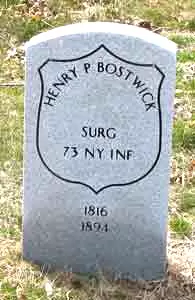
BOSTWICK, HENRY P. (1816-1894). Surgeon, 73rd New York Infantry. Bostwick enlisted as a surgeon at Camp Scott, New York, on June 8, 1861, was commissioned into the 73rd New York’s Field and Staff on September 5, 1861, and was discharged on March 20, 1862. At the time of his death, he resided in Brooklyn. Section 15, lot 17263, grave 381.
BOSWORTH, DAVID C. (1838-1908). First lieutenant, 23rd Regiment, New York State National Guard, Company B. Bosworth was commissioned into the 23rd on June 18, 1863, and mustered out after 30 days on July 22, 1863, at Brooklyn. He last lived at 159 Lafayette Avenue in Brooklyn. His death was attributed to melancholia. Section 158, lot 14996.
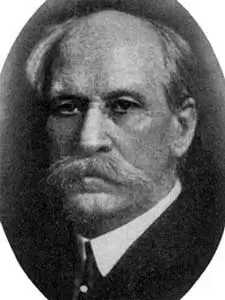
BOSWORTH, FRANCKE HUNTINGTON (1843-1924). Quartermaster sergeant, 148th Ohio Infantry, Company A. He was born in Marietta, Ohio, and educated there and at Yale. He enlisted in the 148th Ohio, Company A, on May 2, 1864, was promoted to quartermaster sergeant, then reduced to ranks on July 24, 1864. He mustered out on September 14, 1864.
After the war, Bosworth was graduated from Bellevue Hospital and Medical College as valedictorian. He is listed as a physician, as Frank Bosworth, in the New York City Directories for 1875-1876 and 1876-1878. His specialty was diseases of the upper air tract; he became a professor in that field at Bellevue in 1881, and continued to teach there until his retirement. In 1881, the first edition of his much-admired Manual of the Diseases of the Throat and Nose was published. His textbook, Diseases of the Nose and Throat (1896), was very popular for a generation. Bosworth, along with two others, created the science of laryngology. He also devised a nasal saw to remove obstructions. He is listed as a physician in the Brooklyn Directory for 1885-1886 and in the New York City Directory for 1891-1892; his practice was at 26 West 46th Street in Manhattan.
A founder of the New York Laryngological Society, Bosworth was so respected internationally that he was named an honorary fellow of the laryngological societies of Britain, France, and Germany. He died from “illuminating gas” on October 17, 1924, at his residence at 148 East End Avenue in Manhattan. Interment at Green-Wood was on October 19, 1925. A widower at the time of his death, one of his sons, who bore his name, was a professor of architecture and dean of the School of Architecture at Cornell University. Section 191, lot 24740.
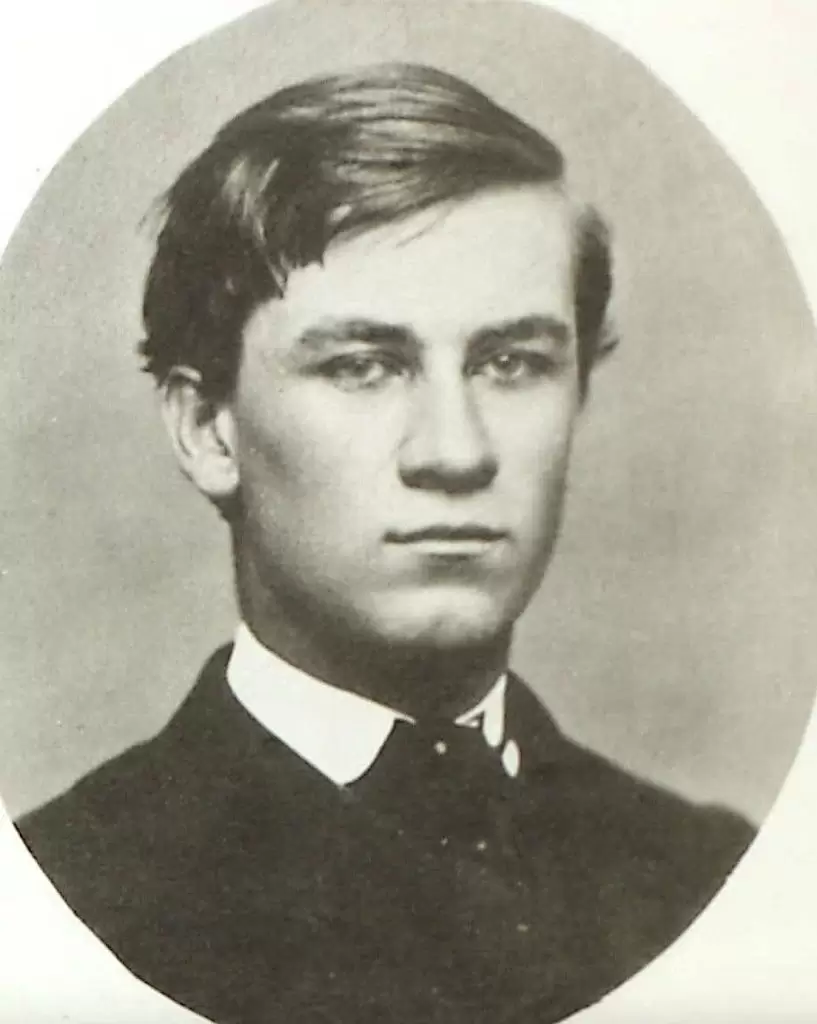
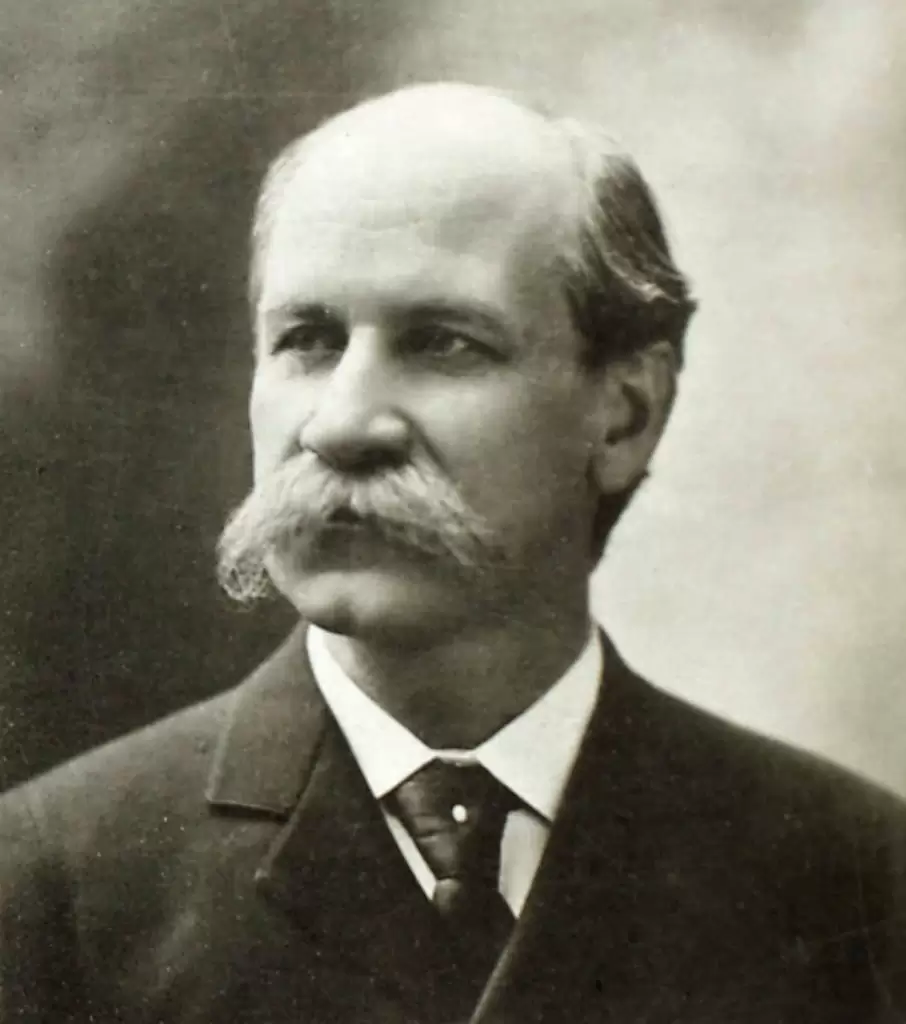
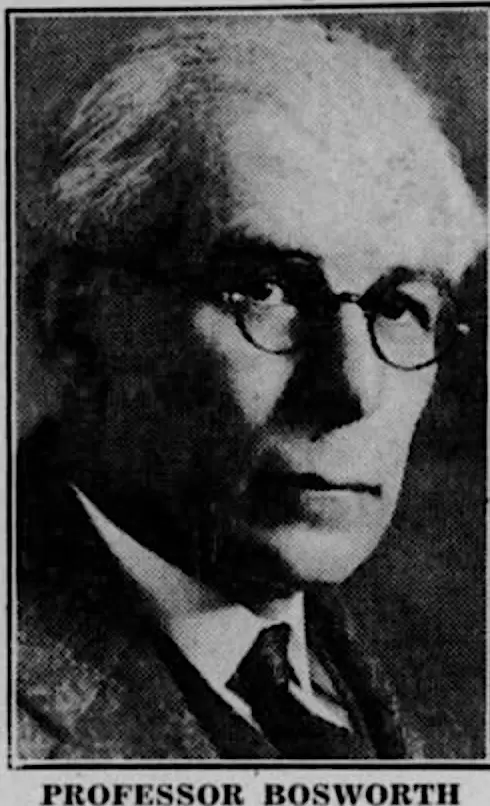
BOSWORTH, GEORGE B. (1843-1911). Major, 87th New York Infantry; 16th New York Cavalry; 3rd New York Provisional Cavalry; private, 8th Regiment, New York State Militia, Company B. Bosworth, a native of the city, was the son of a prominent lawyer and judge and was employed as a clerk according to the 1860 census. After enlisting at New York City as a private on May 24, 1861, he mustered into the 8th Regiment that same day, and mustered out on August 2, 1861, at New York City. Promoted to major on October 15, 1861, he was commissioned into the 87th New York’s Field and Staff on November 19, and was discharged for disability at Harrison’s Landing, Virginia, on July 17, 1862. He returned to service on January 9, 1864, when he was promoted to major and commissioned into the 16th New York Cavalry’s Field and Staff. After being transferred to the 3rd New York Provisional Cavalry’s Field and Staff on August 17, 1865, he mustered out a month later on September 21 at Camp Barry in Washington, D.C.
Bosworth had subsequent service in the United States Army until January 1, 1871. The 1880 census indicates that he was a retired officer. In 1904, he received a pension, certificate 1,323,623. He was the brother of Nathaniel Bosworth (see). His last home was at 167 West 129th Street in Manhattan. Shortly after his death from an aneurysm in 1911, his wife’s application for a widow’s pension was granted, certificate 965,092. Section 159, lot 13692.
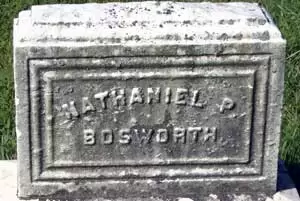
BOSWORTH, NATHANIEL P. (1836-1862). First lieutenant, 4th New York Infantry, Companies F and C. The brother of George Bosworth (see) and son of a prominent judge, he was a clerk according to the 1860 census. He enlisted at New York City as a second lieutenant on April 22, 1861. On May 2, he was commissioned into the 4th New York’s Company F, and on August 26 of that year was transferred to Company C upon his promotion to first lieutenant. After resigning on April 10, 1862, he died six months later of a heart condition at his home at 316 West 22nd Street in Manhattan. Section 159, lot 13692.
BOTT, CHARLES (1836-1924). Private, 12th Regiment, New York State Militia, Company K. Of German origin, Bott enlisted as a private on April 19, 1861, served with the 12th Regiment, and was discharged on August 5. In 1904, his application for a pension was granted, certificate 1,088,305. His last address was 4529 18th Avenue in Brooklyn. Bott died from heart disease. Section 106, lot 10318.
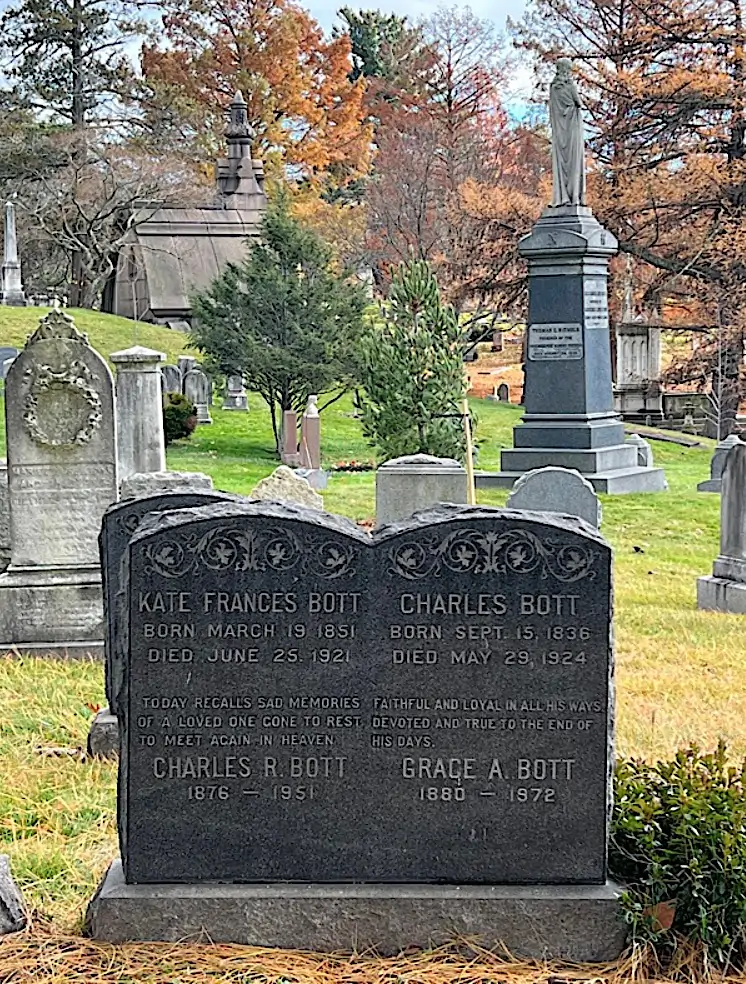

BOTTS, STEPHEN (or STEVEN) K. (or H.) (1836-1909). First lieutenant, 11th New York Cavalry, Company B; second lieutenant, 42nd New York Infantry, Company F; private, 11th New York Infantry, Company E. A native of England, he enlisted as a private on April 20, 1861, at New York City, mustered into the 11th New York on May 7, and was discharged on August 5 of that year for promotion to second lieutenant upon his transfer to the 42nd New York Infantry that day. On August 22, 1862, he re-enlisted as a private at Washington, D.C., and mustered into the 11th New York Cavalry but was not assigned to any company. Botts was promoted to sergeant major two days later, and became a second lieutenant by brevet on September 1, the same day he was transferred to Company B. Two months later on November 1, he became a first lieutenant but was not commissioned in that rank. He was dismissed on January 21, 1863. In 1909, his widow, Mary E. Botts, applied for a pension, application 930,653, but there is no evidence of a certificate being issued. Section 85, lot 1594, grave 9.
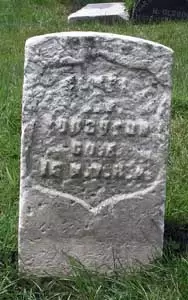
BOUGHTON, SAMUEL B. (1842-1907). Corporal, 16th New York Heavy Artillery, Company E. Boughton, who was born in New York City, was 5′ 6½” tall with blue eyes, dark hair and a fair complexion. He enlisted as a private at Brooklyn on December 14, 1863, and mustered into the 16th Heavy Artillery two days later. At some point, he was promoted to corporal, and mustered out on August 21, 1865, at Washington, D.C.
A carpenter in civilian life, Boughton returned to the Army on January 20, 1866, for a term of three years. His application for an invalid pension was approved in 1891, certificate 844,617. The 1900 census indicates that he had been disabled for the past 12 years. Boughton last resided at 107 Oraton Street in Newark, New Jersey. He died from tuberculosis. In 1908, Annie Boughton applied for and received a widow’s pension, certificate 631,058. Section 6, lot 20118, grave 125.
BOUGHTON, WILLIAM DE LANCEY (1839-1899). First lieutenant, 49th New York Infantry, Company H. Born in Lockport, New York, he enlisted there as a first sergeant on September 10, 1861, mustered into the 49th six days later, and became a second lieutenant on March 30, 1862. He rose to first lieutenant on August 3, 1862, served on the staff of Major General George W. Getty, and was wounded in the face at Fredericksburg, Virginia, on May 4, 1863, while helping an injured fellow soldier. On June 30, 1864, he suffered a spinal injury as a result of being thrown from his horse. Boughton mustered out at Buffalo, New York, on October 18, 1864.
In 1867, Boughton moved to New York City and was employed as a fire insurance broker. He was also a member of the Loyal Legion. On August 12, 1896, he was committed to the Manhattan State Hospital on Ward’s Island for “lunacy.” Interviewed there, he said the following about himself: “I am not happy because I have pains. I am not doing anything and my memory is affected. My mind isn’t very good. I don’t do anything all day but sit around. I have no ambition any more.” His application for an invalid pension was granted in 1895, certificate 912,836. He last lived at 437 West 157th Street in New York City. His death was attributed to paresis (muscle weakness). In 1899, Marion A. Boughton’s application for a widow’s pension was granted under certificate 494581. Section 174, lot 21390, grave 3.
BOURNE, CHARLES C. (1843-1870). Corporal, 13th Regiment, New York State National Guard, Company I. Serving for three months, Bourne enlisted and mustered into the 13th at Brooklyn on May 28, 1862, and mustered out at Brooklyn on September 12. Bourne last resided at 98 Henry Street in Brooklyn. His cause of death was tuberculosis. Section 68, lot 2553.
BOUTEN, HENRY (1803-1884). Sergeant, 14th New York Cavalry, Company B. Born in Amsterdam, Holland, Bouten enlisted on October 17, 1862, and mustered into the 14th New York Cavalry on November 25. A commissary sergeant, he was dropped from the company’s rolls at some point. He last lived at 167 23rd Street in Brooklyn. He died from cancer. Section 192, lot 24055.
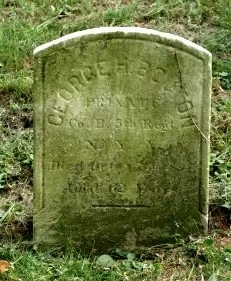
BOUTON (or BOUTEN), GEORGE H. (1829-1891). Private, 5th New York Infantry, Company B. Born in New York City, Bouton, an accountant by trade, was 5′ 8″ with brown eyes and dark hair. He enlisted at New York City on April 25, 1861, and mustered into the 5th on May 9. After suffering from a chronic sore throat, he was assigned as a hospital clerk before being discharged for disability on March 17, 1863, at Convalescent Camp, Virginia. He died from poisoning in Haverstraw, New York. Section 66, lot 14061.
BOUTON, SAMUEL F. (1843-1862). Corporal, 67th New York Infantry, Company A. Born in Brooklyn to Elizabeth A. Bouton (father’s name unrecorded), Bouton enlisted as a corporal there on May 14, 1861, at the age of 19, and mustered into the 67th (also known as the 1st Long Island Volunteers) on June 20, 1861. For unspecified reasons, he was reduced in ranks to private on November 30, 1861. Five months later, Bouton was promoted to the rank of corporal again on April 22, 1862, just before he was wounded in the Battle of Seven Pines, Virginia, on May 31, 1862. On June 12, 1862, he died of those wounds while on passage by ship to New York, nearly a year after he had enlisted into Union service.
Bouton’s death notice, which appeared in the June 14, 1862, edition of New-York Daily Herald, states that his funeral was held that day at his father’s residence, 77 Summit Street in Brooklyn. According to the United States Civil War Pension Index, Elizabeth Bouton applied for and received a mother’s pension in 1874, certificate 286,442. She died in 1907 and is interred in the lot with him. Section 52, lot 971.
BOWER, ALEXANDER LESLIE (1845-1886). Seaman, United States Navy. Originally from Aberdeenshire, Scotland, Bower enlisted as a seaman in the United States Navy in 1864. He saw action on board the USS Mendota defending the Union at the Battle of Deep Bottom, Virginia, on the James River. Bower’s last address was 441 9th Avenue in Manhattan. He died from tuberculosis. After his death, his wife was paid a government pension. Section 2, lot 5499, grave 2150.
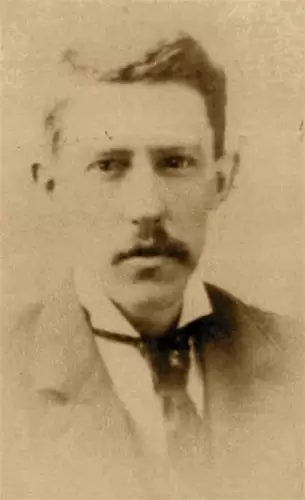
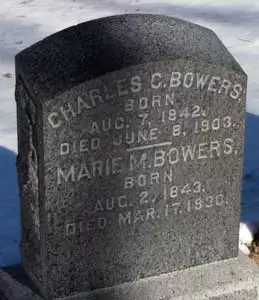
BOWERS, CHARLES C. (1842-1903). Corporal, 16th Connecticut Infantry, Company G. A resident of Berlin, Connecticut, Bowers enlisted as a corporal on August 6, 1862, and mustered into his company on August 24. After he was wounded on September 17, 1862, at Antietam, Maryland, he was discharged for disability on February 24, 1863. On August 22, 1863, he applied for and received an invalid pension, certificate 230,032.
As per his obituary in the Brooklyn Standard Union, he was employed as a buyer for a dry goods firm in Brooklyn. Bowers died from pneumonia. His last address was 978 Sterling Place in Brooklyn. In 1903, his widow, Marie Bowers, who is interred with him, applied for and received a pension, certificate 571, 921. He was also survived by three daughters. His obituary reports that his widow was the sister of George Washington Cable, an American novelist who wrote about Creole life in his hometown of New Orleans, Louisiana, and who served in the forces of the Confederate States of America. Originally interred in lot 31262, his remains were moved on May 28, 1907. Section 131, lot 32540, grave 1.
BOWLES, ROBERT SAMUEL (1842-1927). First sergeant, 19th Virginia Infantry, Company C, Confederate States of America. A native of Fork Union, Virginia, the 1860 census indicates that he was living with his parents; his father was a prosperous hotelier in Charlottesville, Virginia. A teacher, he enlisted as a private at Scottsville, Virginia, on April 17, 1861, and mustered into Company C of the 19th Virginia on May 11. He was promoted to fifth sergeant of his company on April 30, 1862. Wounded in action on June 27, 1862, at the Battle of Gaines’ Mill, Virginia, he returned to his unit and was wounded a second time at the Battle of Gettysburg, Pennsylvania, on July 3, 1863. After being taken as a prisoner of war at Gettysburg, he was paroled at David’s Island near New Rochelle, New York, from the De Camp Military Hospital on July 15, 1863. Subsequent to rejoining his company, he became a second sergeant on October 28, 1863. Although promoted to first sergeant on June 30, 1864, he was later reduced in rank to fourth sergeant on November 7, 1864. On April 6, 1865, he was taken prisoner of war at High Bridge, Virginia, was held in the City Point Prison Camp on April 9, and moved to the infamous prison at Point Lookout, Maryland, on April 14, 1865. Bowles took the Oath of Allegiance at Point Lookout on June 3, 1865, and then was released from confinement and discharged from service.
Bowles married Jennie A. Stratton in Goochland, Virginia, in 1871. The 1880 census reports that he was living in Columbia, Virginia, with his grandfather-in-law and working in “boating.” The census of 1900 indicates that he was living in Brooklyn with his wife and three children and working as a night watchman. He was living in Brooklyn at the time of the censuses of 1910 and 1920. Bowles was a member of the Greene Avenue Baptist Church in Brooklyn for thirty-five years.
His obituary in the Brooklyn Daily Eagle, which confirms his wounding at Pickett’s Charge at the Battle of Gettysburg, notes that he was one of the City’s last two surviving Confederate veterans who belonged to the Confederate Veterans Camp of New York City; the last surviving Confederate member of the organization was expected to attend his funeral. His service in the Confederacy is also noted in his obituary in the Brooklyn Standard Union. He last lived at 174 Prospect Place in Brooklyn. He had been ill in the three weeks prior to his death and was survived by his wife, Jennie, to whom he was married for 55 years, a son and three married daughters. As per his obituary in the Brooklyn Daily Eagle, newspapers in Richmond, Virginia, were asked to print a notice of his death. Section 167, lot 16283.
BOWNE, ELIJAH (1847-1886). Musician, 24th New York Infantry, Company F; 184th New York Infantry, Company B. A New Yorker by birth, Bowne enlisted as a musician at Oswego, New York, on May 7, 1861, mustered into the 24th New York ten days later and mustered out on May 29, 1863, at Elmira, New York. He re-enlisted as a private and mustered into Company B of the 184th New York on September 12, 1864, the same day that he was promoted to musician. Bowne mustered out on June 29, 1865, at City Point, Virginia. He last lived at 229 Smith Street in Brooklyn. Section 3, lot 18372, grave 57.
BOWNE, JEREMIAH H. (1840-1890). Private, 57th New York Infantry, Company E. A New Yorker by birth, he enlisted there on September 21, 1861, mustered into the 57th the next month on October 14, and deserted two days later at New York City. Bowne last resided at 250 West 16th Street in Manhattan. He died from tuberculosis. Section 95, lot 9953.
BOWNE (or BOWEN), ROBERT E. (1845-1893). Private, 89th New York Infantry, Company I. Bowne was born in New York. After enlisting at Delhi, New York, as a private, on September 16, 1861, he mustered into the 89th New York on October 21, 1861, and was discharged on October 21, 1864.
The 1865 New York State census reports that Bowne was living with his parents in Delhi, New York. According to the Veterans’ Schedule of 1890, which confirms his Civil War service and lists his surname as “Bowen,” he was living at 136 93rd Street in Manhattan. As per his obituary in the New York Herald, he was the assistant appraiser in New York. He last lived at 247 West 135th Street in Manhattan. He died from pleurisy. Annie Bowne applied for and received a widow’s pension in 1893, certificate 410,223. Section 15, lot 17263, grave 381.
BOXOLD, GEORGE (1840-1906). Private, 102nd Pennsylvania Infantry, Company D. Born in the United Kingdom, Boxold enlisted on April 5, 1865, as a private. He mustered into the 102nd Pennsylvania as a substitute and mustered out on June 28, 1865, at Washington, D.C.
He is listed as a founder (worker in an iron foundry) in the Brooklyn Directory for 1868 and as a molder in the Brooklyn Directory for 1873-1876. According to the 1880 census and the 1884-1886, 1888-1890, and 1890-1892 Brooklyn Directories, he was employed as an iron molder. In 1904, he received a pension, certificate 1,110,620. His last residence was at 171 Prospect Street in Brooklyn, where both he and his wife were found asphyxiated with a gas valve slightly open. Section 85, lot 32200, grave 26.

BOYCE, FREDERICK (1841-1886). Private, 84th New York (14th Brooklyn) Infantry, Company E; 5th New York Veteran Infantry, Company H. Born in Islington in Middlesex, England, Boyce immigrated to New York in 1854 aboard the Devonshire. A stair-builder by trade and the brother of John (see), he enlisted at Brooklyn on August 15, 1862, and mustered into the 14th the next day. In November 1863, he was sentenced by court-martial to forfeit $5 of his pay, no reason stated. Boyce was taken prisoner on May 14, 1864, at Spotsylvania Court House, Virginia, was confined at Richmond, and released on February 26, 1865, at N.E. Ferry, North Carolina. He was hospitalized March 8, at Annapolis, Maryland, and after March 12, at Baltimore. He returned to headquarters duty with Company H of the 5th Veterans on June 2, 1865, and was discharged at Hart’s Island, New York Harbor, two weeks later.
After the Civil War, Boyce worked as superintendent of repairs for the Brooklyn City Railroad, and was a member of the G.A.R. and the 14th Regiment War Veterans. His last residence was 190 Johnson Street, Brooklyn. Boyce died from bone cancer. His wife, Elizabeth Boyce, received a widow’s pension in 1890, certificate 366,083, and is interred with him. Section 155, lot 25297, grave 2.
BOYCE, JOHN (1844-1929). Private, 84th New York (14th Brooklyn) Infantry. Company E. Originally from Islington in Middlesex, England, Boyce’s family immigrated to the United States aboard the Devonshire in 1854. He enlisted as a private at Brooklyn on August 16, 1862, and mustered into the 14th Brooklyn three days later. His muster roll notes that he was a glass-blower who was 5′ 7½” tall with light hair, light complexion and hazel eyes (his pension application notes that he had blue eyes). Frederick Boyce (see), his brother, served in the same regiment and company.
As per his application for an invalid pension, Boyce stated that at the Battle of Chancellorsville, Virginia, in May 1863, he sustained an injury to his right foot caused by a shell striking a pontoon bridge and driving a splinter into his foot. He was treated for that wound at Baptist Church Hospital in Alexandria, Virginia. The 1863 Draft Registration lists Boyce as a soldier. He became a prisoner of war on May 14, 1864, at Spotsylvania Court House, Virginia, was confined at Florence, South Carolina, and was paroled on February 28, 1865, at Wilmington, North Carolina. On July 3, 1865, he mustered out at Annapolis, Maryland.
At the time of the 1875 New York State census, Boyce was married with young sons and worked as a plumber. The 1880 census reports that he was married, worked as a peddler and lived with his father-in-law, David Duff and family. He applied for and received an invalid pension in 1891, certificate 722,346. On that application, he notes that he was 5′ 9″ tall with a florid complexion, light hair and blue eyes. That application reports that Boyce was a pipe-fitter and was partly disabled from performing manual labor because of his wartime injury. The 1892 New York State census lists him as a steam-fitter. The 1900 census notes that he lived in Brooklyn, was married and was still working as a steam-fitter; he was also listed as a steam-fitter in the 1901 Brooklyn Directory and the 1905 New York State census. Boyce lived with his wife at 8 Nassau Place in Brooklyn at the time of the 1910 census; he was still working as a steam-fitter at that time but no occupation is listed for him on the 1915 New York State census. On September 26, 1915, the Brooklyn Daily Eagle reported that the Boyces had just celebrated their golden wedding anniversary. That article, which confirmed Boyce’s service with the 14th New York in the Civil War, noted that the couple had lived on Nassau Place in Brooklyn for thirty-three years, had seven sons, twelve grandchildren and one great grandchild. In the 1920 census, he is listed as married, living in Brooklyn and retired.
A Freemason, the Brooklyn Daily Times noted that members of Boyce’s lodge were invited to attend his funeral. His obituary in the Brooklyn Standard Union, which confirms his Civil War service, indicates that he was also a member of the Masonic Veterans Association. As per his death certificate, he was a widower who was retired; his wife, Mary Jane Duff Boyce, who is interred with him, died in 1923; he was survived by five sons. He died at the home of his son at 130 Vanderbilt Avenue, Brooklyn, of heart disease.
An article in the Brooklyn Daily Times on May 19, 1929, days after his death, notes that four surviving members of the 14th Veterans Association dressed in their 1861 uniforms were honored guests at the campfire dinner at the 14th Regiment’s Armory. The dinner commemorated the departure of the 14th New York from Brooklyn on May 18, 1861. That article reports that taps was played as a final tribute to John Boyce. Another article about that dinner in the Brooklyn Standard Union, notes that the regiment was referred to as the “Red-Legged Devils,” an appellation given to the 14th by the Confederates for that regiment’s resilience. Section 135, lot 30010, grave 265.
BOYCE, WILLIAM HENRY (1841-1913). Corporal, 173rd New York Infantry, Company F. A native of New York City, he enlisted at Brooklyn as a corporal on August 30, 1862, and mustered into the 173rd New York on October 30 of that year. He was reduced in rank to private on January 1, 1863, and mustered out at Savannah, Georgia, on October 18, 1865.
In 1908, Boyce’s application for an invalid pension was granted, certificate 1,062,868. As per his obituary in the Brooklyn Standard Union, he was a member of the Knights of Honor, a fraternal order and benevolent society, and the Improved Order of Red Men (I.O.R.M.), a fraternal organization that used Native American titles and regalia and focused on temperance and patriotism. He was a member of the Bushwick Central Methodist Episcopal Church. Boyce last lived at 1010 Hancock Street in Brooklyn. He succumbed to nephritis. Mary Wanzer L. Boyce, who is interred with him, applied for and received a widow’s pension shortly after his death in 1913, certificate 760,704. Section 102, lot 7946.
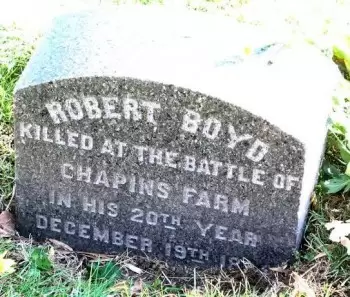
BOYD, ROBERT (1844-1864). Private, 47th New York Infantry, Company K. Of Irish birth, he enlisted at New York City, where he resided, on March 9, 1864, and mustered into the 47th on that date. He died of pyemia on December 19, 1864, at White Hall in Bucks County, Pennsylvania, and was interred two days later. However, his gravestone states that he was killed at the Battle of Chapin’s Farm, Virginia. Section 75, lot 8004.

BOYD, JR., WILLIAM H. (1842-1918). Captain, 21st Pennsylvania Cavalry, Company E; second lieutenant, 1st New York Cavalry, Companies C, L, I, and A. Boyd enlisted as a sergeant at Philadelphia, Pennsylvania, on August 19, 1861, and mustered immediately into Company C of the 1st New York Cavalry. He rose to the rank of quartermaster sergeant on December 12, 1861, and to second lieutenant on September 9, 1862, effective upon his transfer to Company L. He was transferred to Company I on November 1, 1862, and to Company A on February 1, 1863.
During his military service, Boyd was wounded in action and led a detachment of the 1st Cavalry in the skirmish at Upperville, Virginia, on May 6-7, 1863. He was discharged for promotion to first lieutenant on October 2, 1863, when he was commissioned into the Field and Staff of the 21st Pennsylvania Cavalry with the rank of first lieutenant and quartermaster. On February 20, 1864, he was promoted to captain upon his transfer to Company E, and resigned on June 7, 1865. He last resided at 287 Barclay Street in Flushing, New York. His death was attributed to nephritis. Section 163, lot 14760, grave 2.
BOYDEN, GEORGE A. (1828-1910). Private, 7th Regiment, New York State Militia, Company F. Boyden was born in Kingston, New York, and served for 30 days in the 7th Regiment according to his obituary in The New York Times. He was a manufacturer of hats and caps in Manhattan. The Brooklyn Directory for 1870-1873 lists him as being in the hat business at 866 Canal Street in Manhattan; he then lived at 800 Carlton Avenue in Brooklyn. As per his obituary in the Brooklyn Daily Eagle, which also confirms his service in the 7th Regiment, Boyden lived in the Hill district of Brooklyn since 1858. That obituary notes that his hat business was located at 520-522 Broadway. He was a member of the 7th Regiment’s Veteran Association and was a longtime member of the Protestant Episcopal Church of St. James. His last address was 345 Waverly Avenue, Brooklyn. Boyden was survived by two sons and four daughters. His death was attributed to pyemia (staph infection) and apoplexy. Section 114, lot 18407, grave 3.
BOYLAN, THOMAS (1835-1907). Private, 84th New York (14th Brooklyn) Infantry, Company F. Born in Ireland, he enlisted at Brooklyn as a private on April 18, 1861, and mustered into the 14th Brooklyn on May 23 of that year. He was wounded at Second Bull Run, Virginia, on August 30, 1862, and mustered out at New York City on May 23, 1864. He last resided at 208 33rd Street in Brooklyn. Boylan died from nephritis. Section 15, lot 17263, grave 470.
BOYLE, FERDINAND THOMAS LEE (1820-1906). Brigadier general by brevet; colonel, 4th Missouri Enrolled Militia. Born in Ringwood in Hampshire, England, his father, John Boyle, was a well-known composer. He immigrated to the United States when he was eight years old. An artist, he first studied under painter Henry Inman, became a member of the National Academy of Design in 1836, and an associate of the Academy in 1850. After moving to St. Louis, Missouri, in 1855, he founded and was vice president of the Western Academy of Art there. During the Civil War, he was elected colonel of the 4th Missouri and mustered out in 1865 as a brevet brigadier general. Further details are unknown. He also was a member of the St. Louis Sanitary Commission.
Boyle’s allegorical painting, Young Missouri, is a historic work. His portrait of Senator Thomas Denton hangs in the gallery of the Missouri Historical Society. He also painted other famous men of Missouri including Union General Frank P. Blair and Governor Benjamin Gratz Brown. Boyle also painted portraits of Charles Dickens and General Ulysses S. Grant among others; at the time of Boyle’s death, his portrait of Grant was displayed at the Union League Club.
In 1866, he returned to New York, opened a studio at West 30th Street and Broadway, then moved to Brooklyn in 1871 where he became a professor of fine arts, holding that position until 1890. As per his obituary in The New York Times, which confirms his Civil War service, he was a professor of art at the Brooklyn Institute and head of the School of Art at Adelphi College in Brooklyn. Boyle was a friend of Samuel Morse who was also an artist before he gained fame for inventing the telegraph. A Freemason, he also belonged to the New York Sketch Club, the Faust Club of Brooklyn and the Carlton Club. Boyle died from senility at 102 Park Place in Brooklyn, the home of his brother-in-law. He was survived by two married daughters. Section 8, lot 9993.
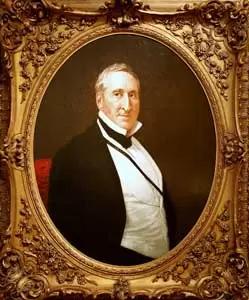

BOYLE, JAMES A. (1819-1892). Captain, 12th Regiment, New York State Militia, Company G; first lieutenant, 12th New York Infantry, Company B. Born in Ireland, he was the owner of a prosperous lithograph business at the start of the Civil War. According to his obituary in The New York Times, he was well-known in the New York National Guard and in 1860 was detailed to guard the Prince of Wales on his visit to New York City and to escort the Japanese Embassy in that same year.
Boyle enlisted at New York City on April 19, 1861, was commissioned into Company G of the 12th New York State Militia on May 2, and mustered out at New York City on August 5, 1861. He subsequently re-enlisted at New York City as a first lieutenant on October 2, 1861, was commissioned into Company B of the 12th Infantry on January 31, 1862, and mustered out on June 30, 1863. His daughter was married to William S. Keiley (see), a Confederate officer, who at the time of Boyle’s death was employed in the Clerk’s Office at the New York Court of Common Pleas. His last residence was 155 West 47th Street in Manhattan. He died from gastritis. Section 183, lot 20394.
BOYLE, JOHN C. (1823-1874). Unknown soldier history. Although specific details about Boyle’s Civil War service are unknown, there is a G.A.R. shield next to his gravestone indicating membership in Peter Cooper Post #313. His last residence was the Madison Avenue Hotel in Manhattan. Boyle died from a hemorrhage. Section 148, lot 21857.
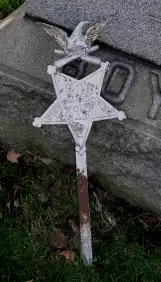
BOYLE, WILLIAM S. (1847-1925). Musician, 4th New York Infantry, Company K; drummer, 15th New York Engineers, Company B. Born in the British West Indies, Boyle enlisted as a musician at New York City on October 11, 1861, mustered into the 4th Infantry that day, and mustered out on May 25, 1863, at New York City. He re-enlisted as a drummer on March 24, 1864, at New York City, mustered immediately into the 15th Engineers, and mustered out on July 2, 1865, at Washington, D.C. Boyle’s last address was 206 Beverly Road in Brooklyn. His death was caused by heart disease. Section 4, lot 21316, grave 233.
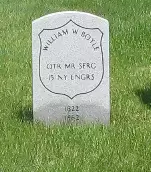
BOYLE, WILLIAM W. (1822-1862). Quartermaster sergeant, 15th New York Engineers, Company D. Boyle enlisted as a private at New York City on May 11, 1861, and mustered into the 15th Engineers with the rank of quartermaster sergeant on June 25. He was discharged for disability at Camp Lincoln, Virginia, on June 19, 1862. His last residence was in Shrewsbury, New York. Section 102, lot 224.
BOYNTON, ALPHEUS C. (or G.) (1827-1880). Private, 102nd New York Infantry, Company F. After enlisting on April 11, 1865, at New York City, he mustered immediately into the 102nd New York, and mustered out on July 21, 1865, at Alexandria, Virginia. At the time of the 1880 census, he was a retired merchant. His last residence was at 211 East 121st Street in Manhattan. Boynton died from tuberculosis. Section 84, lot 9912.
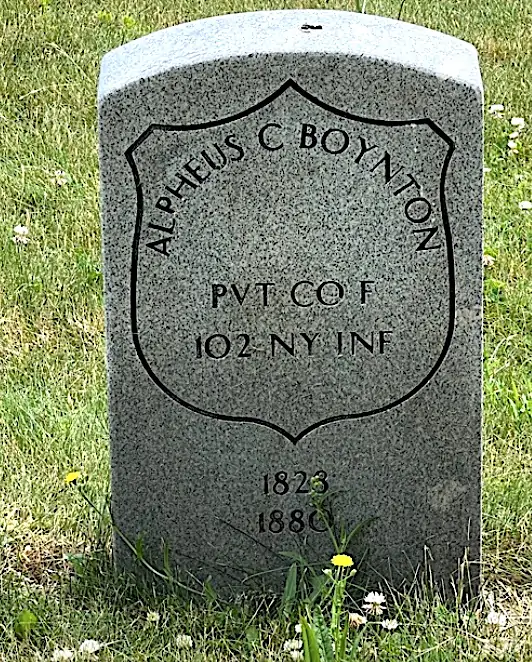
BRADFORD, JOHN O. (1815-1879). Purser, United States Navy. Born in Delaware, Bradford began his career in the Navy as a purser on March 14, 1845, at which time he was attached to the sloop Saratoga from 1845-46. He then served in the Home Squadron from 1846-48, and was on the Portsmouth off the coast of Africa from 1849-51. In 1854-55, he was at the Navy Yard at Boston, then headed for the East India Squadron on the San Jacinto from 1855-58.
At the start of the Civil War, Bradford was aboard the Boston, a receiving-ship, an assignment that lasted from 1860-61. After a year at the Boston Navy Yard in 1862, he was sent to the West Gulf Blockading Squadron in 1863, was fleet paymaster in the South Atlantic Blockading Squadron from 1863-64, and then was the inspector of provisions at New York from 1865-67. Bradford was fleet paymaster of the European Squadron until 1869 at which time he became paymaster at New York. The Brooklyn Directory for 1870-1873 lists Bradford as being in the United States Navy; he then lived at 57 South Oxford Street. He rose to pay director on March 3, 1871, and to paymaster-general on February 18, 1873. He retired from service on February 22, 1877. His obituary in the New York Herald confirms his aforementioned career service in the United States Navy. His last address was 114 Montague Street in Brooklyn; his death was attributed to pneumonia, . Section 183, lot 20634.
BRADFORD, STEPHEN T. (1835-1908). Private, 13th Regiment, New York State National Guard, Company G. A native New Yorker, he enlisted at Brooklyn on May 28, 1862, mustered into the 13th that day, and mustered out after three months at Brooklyn on September 12.
In civilian life, he was a coal merchant. He is listed as as being in the coal business in the Brooklyn Directories for 1864, 1867-1870, 1870-1873, 1873-1876, 1884-1886 and 1890-1892. He applied for an invalid pension in 1904 that was granted under certificate 1,083,836. As per his obituary in the New York Evening Post, which confirms his Civil War service, he had been a member of the Hanover Place Baptist Church for 35 years. His death was also announced in the Hudson, New York’s Columbia Republican. That newspaper noted that his wife, Virginia (Lavinia) Greenleaf, had graduated from Claverack College in 1861 and that Bradford was one of Brooklyn’s oldest dealers in coal and wood; the Brooklyn Standard Union noted in its obituary that Bradford’s business was at 271 Atlantic Avenue.. Bradford last resided at 34 Sterling Place in Brooklyn. He died from nephritis and was survived by his wife and two daughters. Lavinia G. Bradford, applied for and received a widow’s pension in 1908, certificate 657,812. Section 69, lot 3499.
BRADFORD, THOMAS J. (1835-1912). Private, 84th Regiment, New York State National Guard, Company A. A Brooklynite by birth, Bradford enlisted there and enrolled in the 84th New York State Militia for 30 days in 1863. He was discharged at the expiration of his enlistment. In 1907, he applied for and was granted a pension, certificate 804,892. His last address was 109 Bay 31st Street in Brooklyn. Bradford died from heart disease. In 1913, his wife applied for and received a widow’s pension, certificate 704,622. Section 59, lot 2192.
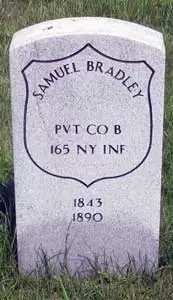
BRADLEY, SAMUEL J. (1843-1890). Private, 165th New York Infantry, Company B. Bradley was born in New York City. During the Civil War, he enlisted as a private on September 16, 1862, at New York City, and mustered into the 165th on November 28. As per his muster roll, he was a milkman who was 5′ 7″ tall with black eyes, black hair and a light complexion. His muster roll notes that he was absent and sick at Baton Rouge, Louisiana, on May 19, 1863, and returned to his company that August. On December 5, 1864, he was detached as an ambulance driver and returned to his regiment on March 1, 1865. He mustered out with his company on September 1, 1865, at Charleston, South Carolina.
In 1887, Bradley’s application for an invalid pension was approved, certificate 418,477. As per his obituary in the New York Herald, he was a member of the Noah L. Farnham Post #458 of the G.A.R. and the Puritan Temple of the Templars of Liberty, a benevolent association known to be “patriotic” and anti-Catholic; members of both groups were invited to attend his funeral. In addition, the Veteran Association of the 165th New York invited its members to attend the funeral of their comrade. His last residence was 1654 Seventh Avenue in Manhattan. Bradley’s death was attributed to diarrhea. Margaret Bradley applied for and received a widow’s pension in 1890, certificate 340,178. Section 126, lot 2458, grave 1037.
BRADNER, THOMAS SCOTT (1822-1898). Chaplain, 124th New York Infantry. A New York State native, Bradner was a Princeton graduate and pastor of several Presbyterian churches in New York and Pennsylvania in his lifetime. During the Civil War, he enlisted as a chaplain on August 23, 1862, at Goshen, New York, and mustered into the Field and Staff of the 124th New York on October 21. Serving throughout the hostilities, he mustered out on June 3, 1865, at Washington, D.C.
Bradner’s obituary in the New York Tribune, which confirmed his service in the Civil War as a chaplain, reported that surviving members of the 124th New York were invited to attend his funeral. As per his obituary in New Jersey’s Red Bank Register, Colonel Charles H. Weygant, the last commander of the regiment, was present at his funeral as were members of the G.A.R.’s Arrowsmith Post #61 of Red Bank, New Jersey. Bradner’s casket was draped in an American flag and was decorated with the sword that he carried in the War. He last lived with his daughter and son-in-law in Red Bank, New Jersey. He died from degeneration of the liver and kidneys. A widower, he was survived by four daughters and two sons. Newspapers in Goshen and Glen Cove, New York, were asked to print a notice of his death. Section 157, lot 20510, grave 4.
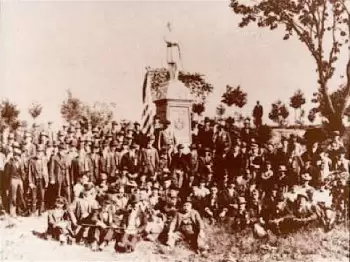
BRADSHAW, WILLIAM H. (1837-1866). Private, 11th New York Infantry, Company C. Born in New York State, Bradshaw enlisted as a private on April 20, 1861, at New York City, mustered into the 11th New York on May 7, and mustered out on June 2, 1862, at New York City. His last residence was 48 Suffolk Street in Manhattan where he died from consumption. Section 114, lot 10131.
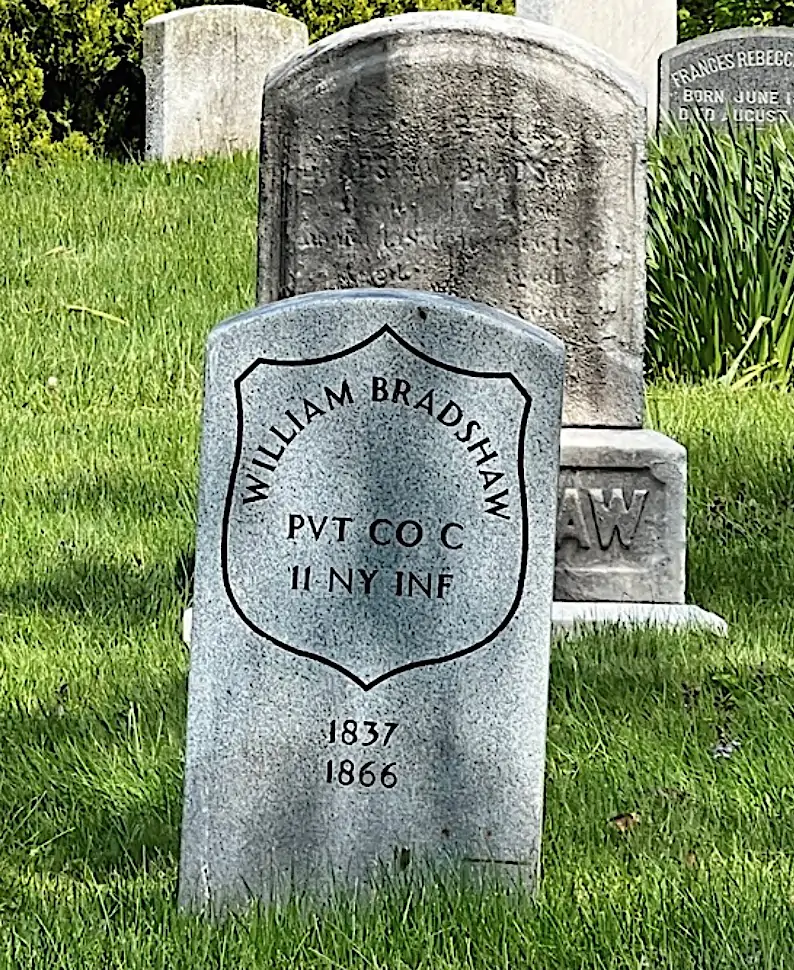
BRADWAY, SILVANUS (or SYLVANUS) C. (1839-1887). Second lieutenant, 12th Regiment, New York State Militia, Company G. Bradway, who was born in New York City, enlisted there as a sergeant on April 19, 1861, mustered into his company on May 2, and mustered out after three months on August 5 at New York City. When the 12th Regiment was reactivated for 30 days in 1863, and part of the New York State National Guard, he was commissioned into the same company as a second lieutenant on July 4, and mustered out on July 20, 1863, at New York City.
In civilian life, Bradway was employed as a merchant. He is listed as being in the poultry business at Washington Market in the New York City Directory for 1877 and in the Brooklyn Directory for 1885-1886. He last resided at 359 West 32nd Street in Manhattan; his death was attributed to malarial fever. Section L, lot 20098.
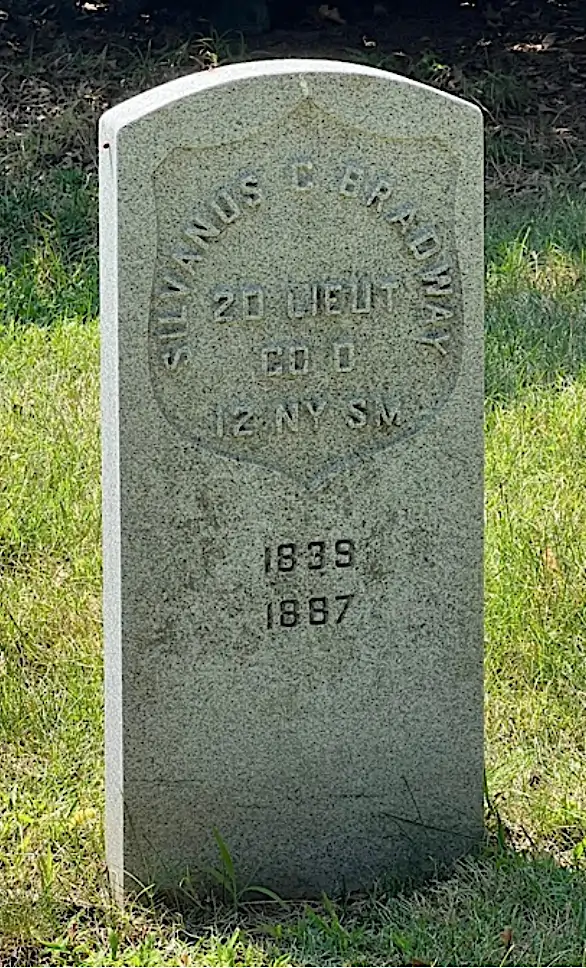
BRADY (or BRADEY), STEPHEN (1846-1926). Seaman, United States Navy. Brady was born in New York and served in the United States Navy during the Civil War. According to the application to the War Department for a headstone, he served as a seaman on the gunboat St. Paul and on the Great Western. Brady was honorably discharged on September 18, 1864.
The 1900 census notes that Brady had been married for 26 years and lived in Manhattan; the 1910 census reports that he worked as a harbor engineer, lived on Amsterdam Avenue, and was able to read and write. As per the census of 1920, Brady was a laborer who lived in Manhattan. He last lived at 191 West 102nd Street in Manhattan. He died after being struck by a trolley car. Mary A. Brady, his widow, applied for a government-issued headstone on November 19, 1927, citing that her husband was a retired veteran of the Civil War. Section 192, lot 23668.
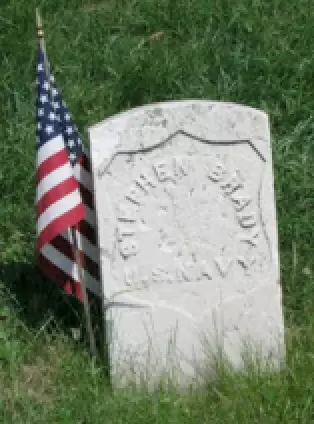
BRADY, WILLIAM (1817-1895). Private, 173rd New York Infantry, Company B. After enlisting at age 44 at Brooklyn on September 10, 1862, he mustered into the 173rd New York on October 30, and deserted shortly thereafter on November 5 at New York City. He last lived at 44 King Street in Manhattan where his death was attributed to senility. Section 163, lot 14496, grave 5.
BRADY, WILLIAM T. (1833-1909). Quartermaster, 62nd New York Infantry, Company A. Of Irish birth, he enlisted as a private at New York City on May 23, 1861, and mustered in on June 30. His military service was marked by promotions to sergeant on August 26, 1861, first sergeant on December 2, 1861, second lieutenant on July 8, 1862, and first lieutenant on March 28, 1863. He was wounded at Fredericksburg, Virginia, on May 4, 1863, promoted to quartermaster but not mustered in that rank on April 29, 1864, and mustered out on June 29, 1864, at Petersburg, Virginia.
According to the censuses in 1870 and 1880, Brady was employed as a letter-carrier. In 1884, his application for an invalid pension was granted, certificate 313,382. The census for 1900 lists Brady as a silversmith. He last lived at 271 West 38th Street in Manhattan. The cause of his death was nephritis. Section 167, lot 16347, grave 3.
BRAEUNLICH (or BRAENNLICH, BRAUNLICH), KARL (or CHARLES) E. (1840-1888). Major, 2nd Arkansas Infantry (Union); first lieutenant, 18th Iowa Infantry. Born in Saxony, Germany, he was a resident of Clinton, Iowa, when he enlisted on July 28, 1862. Braeunlich was commissioned into the Field and Staff of the 18th Iowa the same day that he was promoted to first lieutenant and adjutant on August 8. After he rose to major on February 24, 1864, at Little Rock, Arkansas, his promotion became effective when he was commissioned into the Field and Staff of the 2nd Arkansas on May 23, 1864. He mustered out on August 8, 1865.
The Brooklyn Directory for 1880-1882 lists him as a music teacher who lived at 43 4th Place in Brooklyn, which was also his address at the time of his death. His service in the 2nd Arkansas is inscribed on his tombstone. Section 203, lot 26438.
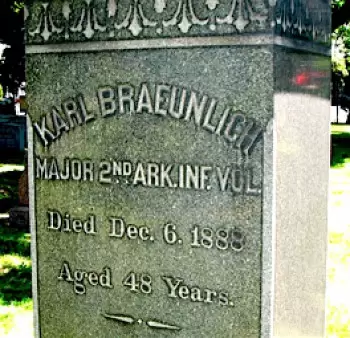
BRAGAW, TOWNSEND (1845-1919). Private, 6th New York Cavalry, Company C; 2nd New York Provisional Cavalry, Company C. A native of Woodside, Queens, he was a clerk according to the 1860 census. His family roots on his father’s side trace back to colonial times to Newtown (now part of Queens). Bragaw enlisted on February 20, 1864, and mustered into the 6th New York Cavalry two days later. Taken as a prisoner of war at Trevillian Station, Virginia, on June 11, 1864, he was incarcerated at Lynchburg and then at the infamous Andersonville Prison in Georgia, and paroled at Savannah, Georgia, on November 30, 1864. However, in a document that he submitted to the National Tribune in Washington, D.C., a publication dedicated to the interests of Civil War veterans, when ex-prisoners of war were uniting to get special pension legislation passed by Congress, he states that he was released to Annapolis, Maryland, and paroled in March 1865. After being transferred into the 2nd New York Provisional Cavalry, which was organized by the consolidation of the 6th and 15th Regiments on June 17, 1865, he mustered out on August 9, 1865, at Louisville, Kentucky. In the aforementioned document to the National Tribune, he states that he was discharged at Elmira, New York, on August 26, 1865. (The Bragaw’s document has no date but he was receiving a pension of $8 a month so it had to be after his application for an invalid pension was certified. The publication was circulated from 1877-1917.)
In 1879, Bragaw’s application for an invalid pension was approved, certificate 241,207. According to the Brooklyn Directory for 1888-1890, he was employed as a foreman and lighterman (operator of a barge). An article in the Long Island Star on January 11, 1890, states that his left arm just had been badly burned by naphtha in a boating accident that confined him to his house to recuperate. In 1910, he was employed as a clerk. Bragaw was a member of the Henry M. Lee Post #21 of the G.A.R. In 1914, his name appeared on a list of survivors of Andersonville, confirming his capture at Trevillian Station. As per his obituary in the Brooklyn Daily Eagle, he was a Freemason; members of his lodge were invited to attend his funeral. He died at the home of his niece at 803 Putnam Avenue in Brooklyn. Section 131, lot 33275, grave 1.
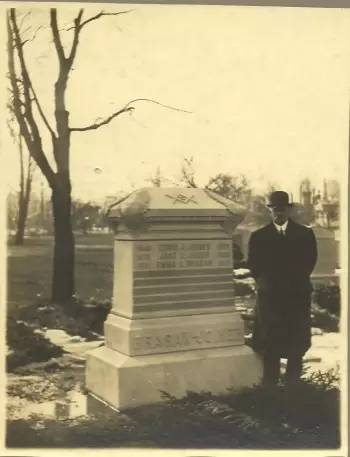
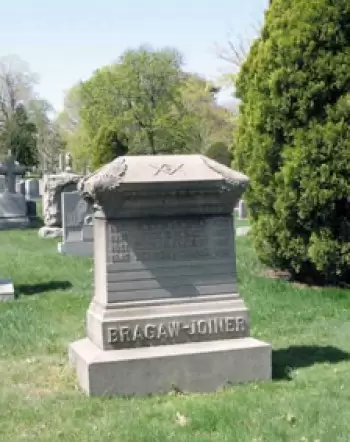
BRAGG, HENRY M. (or W.) (1844-1871). Major by brevet; captain and aide-de-camp, United States Volunteers, Aide-De-Camp; second lieutenant, 13th Regiment, New York State National Guard, Company C; 139th New York Infantry, Company K. On May 28, 1862, Bragg, a New York native and member of a well-to-do family whose American roots could be traced to colonial times, enlisted and mustered into Company C of the 13th New York where he was commissioned as a second lieutenant. After three months, he mustered out with his company on September 9. He was immediately commissioned as a second lieutenant in the 139th New York. The 139th took part in many actions in Virginia including: Fort Magruder, Crumps Crossroads, Chickahominy, Forge Bridge, Richmond, Petersburg, Drewry’s Bluff, and Bermuda Hundred. On August 17, 1864, he was discharged for promotion and commissioned into the United States Volunteers, Aide-De-Camp, as a captain and aide-de-camp. Bragg served as aide-de-camp to General Quincy Gillmore. By some accounts, Bragg was given the honor of raising the American flag over Fort Sumter at the ceremonies of April 14, 1865. He was promoted to major by brevet on March 13, 1865, and mustered out on November 3, 1865.
After the war, Bragg served in the United States Army until November 17, 1869. He last resided at 147 Remsen Street in Brooklyn where he died from an overdose of chloral hydrate (a depressant used to induce sleep). According to the coroner’s inquest, the death may have been accidental. The medication, originally prescribed for his father who had died a few weeks earlier, was refilled by Bragg’s brother at Henry’s request. Bragg fell into unconsciousness soon after taking the drug. Section 27, lot 9716.
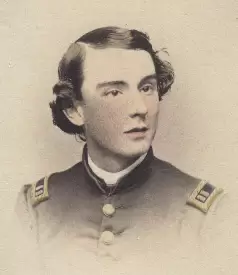
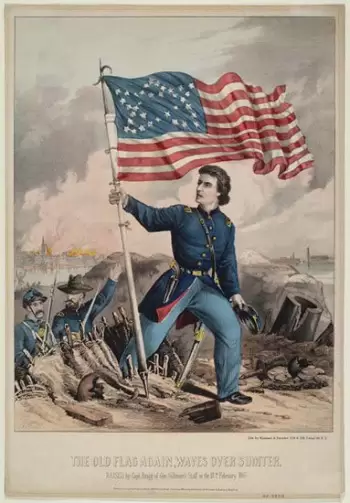
BRAINE, DANIEL LAWRENCE (1829-1898). Lieutenant commander, United States Navy. Born in New York City, he was appointed midshipman on May 30, 1846, and served during the Mexican War at Alvarado, Tobasco, Tuspan, Laguna, Tampico and Vera Cruz. He then had assignments in the Home Squadron, the West Indies, South America, the Mediterranean, and Africa prior to the Civil War. Braine rose to passed midshipman on June 8, 1852, to master in 1855, and to lieutenant on September 15, 1858.
During the Civil War, Braine commanded the Monticello, as part of the Atlantic Blockading Squadron, and was a participant in the capture of Forts Hatteras and Clark in North Carolina on October 5, 1861. At Hatteras, he helped rescue the 12th Indiana Regiment who were surrounded by rebel forces. Braine also took part in the engagement at Sewell’s Point, Virginia, the Civil War’s first naval battle. He was commissioned lieutenant commander on July 16, 1862. He also commanded the Vicksburg and the Pequot in the attacks on Fort Fisher, Fort Anderson, and other forts on the Cape Fear River leading to Wilmington, North Carolina.
Braine is listed as being in the United States Navy in the Brooklyn Directories for 1864, 1868 and 1880-1882; he lived on 2nd Place. He was assigned to ordnance duty at the New York Navy Yard from 1866-67, rose to commander on July 25, 1866, was at the helm of the Hartford in the Asia Squadron from 1867-8, returned to the New York Navy Yard for equipment duty in 1869, and commanded the Juniata during the ill-fated Polaris expedition to Greenland. He was promoted to captain on December 11, 1874, to commodore on March 2, 1885, to rear admiral on September 4, 1887, and retired from service on May 18, 1891. As per his obituary in the New York Herald, he was a member of the Military Order of Loyal Legion, a patriotic group of Civil war officers; companions from that organization were invited to attend his funeral. He last lived at 67 1st Place in Brooklyn; his death was caused by angina. His funeral took place at St. Paul’s Church on Clinton and Carroll Streets in Brooklyn.
In World War II, a warship, the Braine, named in his honor, participated in many actions including those at Wake Island, the Marianas, and Bataan, and escorted supply and troop transports, earning nine battle stars for her service. The Braine served the United States for 28 years and served 13 additional years with the navy of Argentina. Section 192, lot 23839, grave 1.
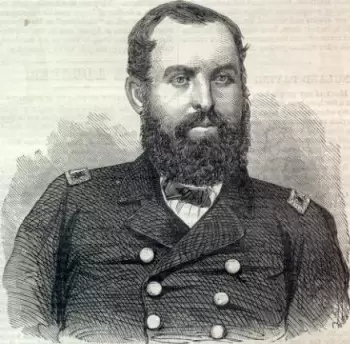
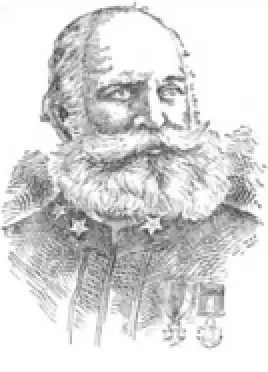
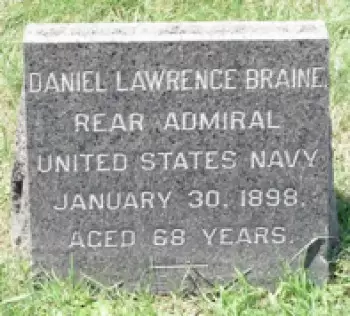
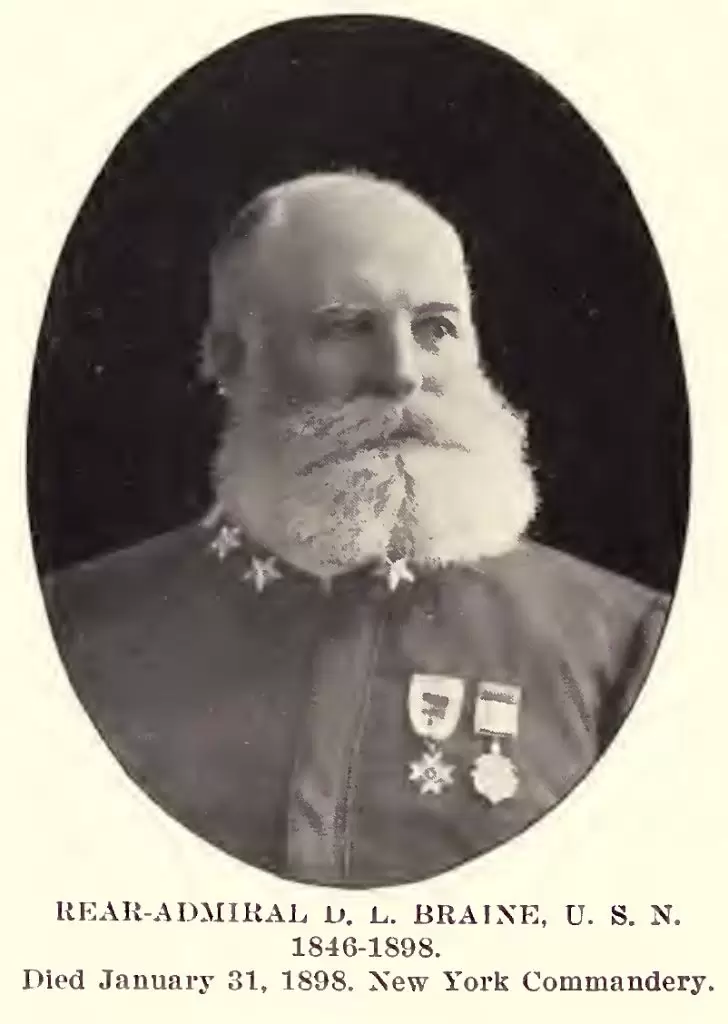
BRAISTED, JR., PETER DeGROOT (1823-1896). Color sergeant, 7th Regiment, New York State Militia, Company E. Braisted, a native of New York, served three tours of duty in the 7th Regiment beginning as a corporal for 30 days in Company E in 1861. He returned to the same regiment and company (then part of the New York State National Guard) for 30 days as a sergeant in 1862. In 1863, he joined the regiment’s Field and Staff for 30 days as a color sergeant. In 1871, he applied for and received an invalid pension, certificate 668,422. His pension record also indicates service in the 2nd United States Army.
The New York City Directories for 1875-1876 and 1877 list Braisted as working in billiards at 14 Fourth Avenue; he then lived at 305 West 4th Street. As per the 1880 census, he lived in New York City, was married and kept a billiard room. He became a member of the G.A.R. in April 1894. As per his obituary in the New York Herald, he was a faithful member of the 7th Regiment for 50 years and was brevetted to second lieutenant; veterans of the 7th Regiment were requested to attend his funeral. Braisted last lived at 305 West 4th Street in Manhattan. His cause of death was diabetes. His funeral took place at the Masonic Hall on Sixth Avenue and West 23rd Street. He was survived by his wife, Eliza Braisted. Section 145, lot 24398, grave 3.
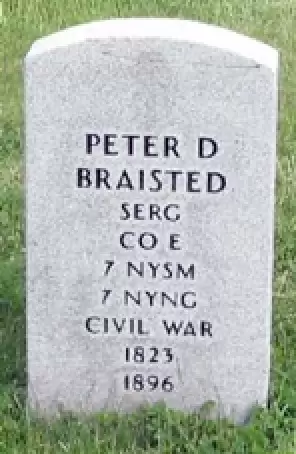
BRAMHILL, WILLIAM CLARK (1839-1875). Private, 83rd New York Infantry, Company G; Veteran Reserve Corps. A Brooklynite by birth, Bramhill enlisted at New York City as a private on May 27, 1861, and mustered into the 83rd New York that same day. On June 26, 1863, he transferred into an unknown company of the Veteran Reserve Corps. He is likely the William C. Bramhill who is listed as being in the rubber business in the Brooklyn Directories for 1863, 1865, 1868, 1870-1873 and 1873-1876; that business was last at 59 Fulton Street in Manhattan. His last residence was 27 Adelphi Street in Brooklyn. Section 116, lot 4073, grave 104.
BRANDT, FREDERICK S. (1816-1902). Captain of merchant vessels. Originally from Hamburg, Germany, he settled in South Brooklyn at age fourteen. First employed on whaling ships, he then joined the company of James E. Ward remaining with them for more than 40 years. He operated vessels between New York and Havana, Cuba. Brandt commanded the Ocean Home, a deep sea bark, then captained the Doris Eickhoff.
He is listed as a shipmaster in the Brooklyn Directory for 1857-1862. During the Civil War, Brandt was on a ship bound for Havana, Cuba, carrying a rich cargo. According to his obituary in the Brooklyn Daily Eagle, the crew mutinied and tried to turn the vessel over to the Confederates but Brandt quelled the mutineers and steered the ship safely to port. He is listed as a seaman in the Brooklyn Directory for 1873-1876 and as a shipmaster in the Brooklyn Directory for 1884-1886.
He was a life member of the Masonic Order, Joppa Lodge #201, in Brooklyn, and followed its principles rigorously. As per his obituaries in The New York Tribune and the Brooklyn Standard Union, which confirm that he saved his vessel during the Civil War, he was the oldest member of his Masonic order in Brooklyn. His last residence was at the Sailors Home in Snug Harbor, Staten Island, where he lived for 17 years; his obituaries note that he chose to live at the Sailors Home in preference to taking a liberal pension and living elsewhere. Brandt died from acute enteritis. His funeral, including a Masonic service, took place at the home of his son at 361 5th Street in Brooklyn. He was also survived by his wife of 60 years, Hannah Bell, a native of St. John, New Brunswick, Canada, and two daughters. Section 171, lot 11300, grave 8.
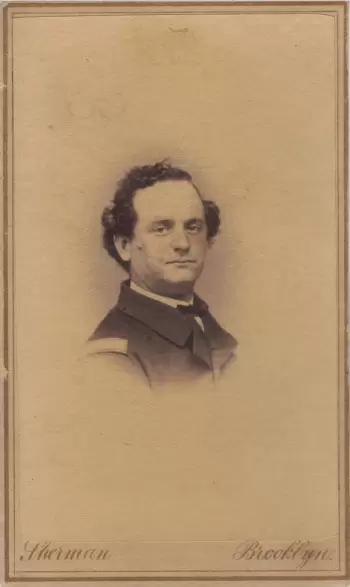

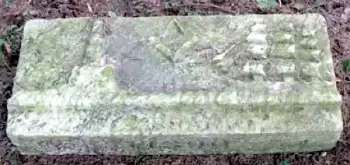
BRASHER, THOMAS M. (1818-1888). Commander, United States Navy. A New York City native, his father, Phillip Brasher, was a local politician and friend of President Andrew Jackson. His father helped secure him an appointment as midshipman in the United States Navy when he was just thirteen on June 15, 1831. At that time, he was assigned to the warship Falmouth in the Pacific Squadron until 1834. Subsequently, Brasher was transferred to the Potomac, went to the Naval School in New York City, became a passed midshipman on June 5, 1837, then served on the USS St. Louis. He was commissioned lieutenant on September 8, 1841, was assigned to the sloop Dale, the brig Lawrence and later served on the frigate Cumberland during the Mexican War. The Brooklyn Directory for 1857-1862 lists him as being in the United States Navy and living at 25 Smith Street in Brooklyn.
On April 24, 1861, he was commissioned commander and assigned to the brig Bainbridge in the North Atlantic Blockading Squadron. With Brasher at the helm, the Bainbridge captured the Newcastle which was carrying a cargo of cotton and turpentine and assisted the USS Amanda off the coast of the Tortugas in capturing the Swan which carried a cargo of cotton and rosin. After he retired in 1862, he was detailed to special duty at the Pensacola Navy Yard in Florida where he was in charge of the storeship of the South Pacific Squadron.
Brasher was made a captain in 1867. In 1868, Brasher became a lighthouse inspector, served in that capacity for two years, and then retired from service in the Navy. As per the Brooklyn Directory for 1867-1870, he was in the United States Navy; he still lived at 25 Smith Street. He last lived at 182 Livingston Street in Brooklyn where he died shortly after complaining about the heat. (His obituary in The New York Times stated that the actual cause of his death was heart disease.) Section 84, lot 1692.
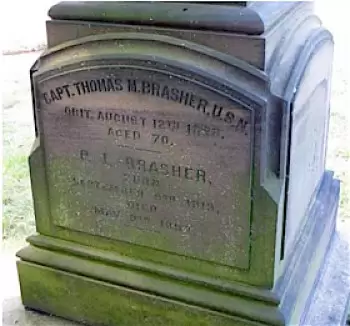
BRAUN, LORENZ (or GEORGE) (1825-1882). Private, 20th New York Infantry, Company G. Of German birth, he enlisted as a private at New York City on September 5, 1861, mustered into the 20th New York four days later, and was discharged for disability on January 14, 1863, at White Oak Church, Virginia. He last lived in Long Island City, Queens. Section B, lot 9895, grave 850.
BRAUN, VALENTIN (or VALENTINE) (1831-1879). Private, 6th Regiment, New York State National Guard, Company E. Of German origin, he enlisted in 1863 and served for 30 days with the 6th Regiment’s National Guard. His last address was on Vernon Avenue in Long Island City, New York. Section 15, lot 17263, grave 2484.
BRAUNSTEIN, FRANCIS (or FRANZ) (1829-1864). Captain, 15th New York Heavy Artillery, Company D; lieutenant, New York 3rd Battalion of Artillery, Company D. Of German birth, he lived on Avenue A in New York City before the Civil War. He enlisted at New York City as a second lieutenant and was commissioned into the 3rd Battalion on November 25, 1861. On April 20, 1862, he was promoted to first lieutenant and transferred to the 15th New York Heavy Artillery on September 30, 1863, when the 3rd Battalion became a part of that regiment. Braunstein was promoted to captain on May 10, 1864, but did not muster in that rank. Wounded in action at Cold Harbor, Virginia, on May 31, 1864, he died of his wounds at Lincoln Hospital, Washington, D.C., on June 10, 1864, and was interred at Green-Wood on June 26. Section 115, lot 13536 (Soldiers’ Lot), grave 2.
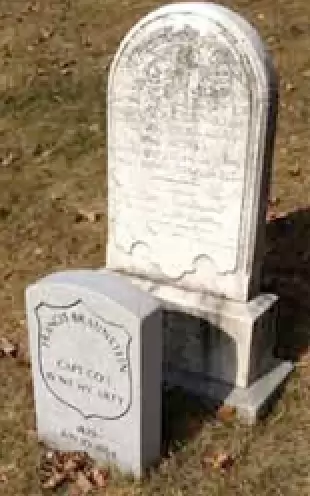
BREAKELL, CHARLES (1843-1906). Private, 79th New York Infantry, Company G. A native New Yorker, Breakell enlisted at New York City as a private on May 13, 1861. He mustered into the 79th on May 28, and deserted three months later on August 25 at Warrenton, Virginia. He last lived at 66 West 171st Street in Manhattan. Breakell died from apoplexy. Section 72, lot 3485.
BREAKEY, JOHN (1847-1893). Ship’s corporal, United States Navy. Of Irish origin, he became a naturalized citizen on October 25, 1848. Breakey was 16 years old when he enlisted in the United States Navy as a first class boy on November 18, 1863. He was 5′ tall with grey eyes, light brown hair, a fair complexion and scars on his forehead and left little finger. He served as a ship’s corporal on the USS Fuschia until his discharge on August 3, 1866.
Breakey’s military service is confirmed by the 1890 Veterans Census for Ridgefield, New Jersey. He last lived in Ridgefield Park, New Jersey. His death was attributed to pleurisy and heart failure. Section 135, lot 27263, grave 643.
BREEZE, JOHN E. (1847-1927). Musician, 35th Indiana Infantry, Company K; drummer, 55th Regiment, New York State National Guard, Company F. Of English birth, Breeze enlisted on December 12, 1861, as a musician, and mustered into Company K of the 35th Indiana from which he was discharged for disability on June 9, 1862. In 1863, he enlisted as a drummer and served for 30 days in Company F of the 55th New York State National Guard.
His application for an invalid pension in 1899 was granted, certificate 1,154,052. Breeze was a member of the Phil Kearny Post #8 of the Grand Army of the Republic. H last address was 1891 Prospect Avenue in the Bronx. His death was attributed to heart disease. Section 128, lot 32177, grave 2.
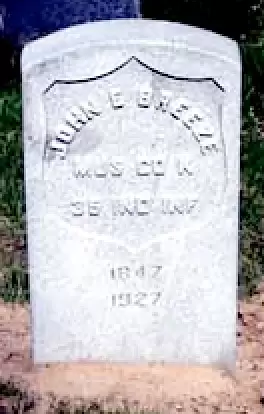
BREHE (or BRAY, BRAHE), JOHN (1844-1865). Uncertain soldier history. A native of Germany, John Brehe, according to cemetery records of the Soldiers’ Lot, served in the 14th New York Cavalry. Also according to cemetery records, he died of chronic diarrhea at Brooklyn College Hospital on January 23, 1865, and is interred in the Soldiers’ Lot (Lot 13536, grave 100). If the cemetery’s records are correct, and he did serve in the 14th, then he is the same soldier who served in the 69th New York Infantry, Company B, the 57th New York Infantry, Company B, and the 18th New York Cavalry, Company A. That man, listed in Civil War service records as John Brehe, enlisted and mustered into the 69th at New York City on May 26, 1862, served three months, and mustered out at New York City on September 3. He re-enlisted the next month on October 24 at Flushing, New York, as a private, and mustered into Company B of the 14th New York Cavalry on November 25, serving in that company until his transfer to Company A on August 1, 1863. He then re-enlisted and mustered into the 57th New York at Williamsburg, New York, on July 8, 1864. On August 25, he was wounded and taken as a prisoner of war at Reams’ Station, Virginia, and subsequently released.
Though the cemetery records indicate a date of death of January 23, 1865, for the man interred in the Soldiers’ Lot, the soldier history for this most likely match lists him as sick on April 30, 1865, at Long Island Hospital, transferring into the 18th New York Cavalry on an unspecified date, and deserting on August 16, 1865. His last residence was in Brooklyn. Section 115, lot 13536 (Soldiers’ Lot), grave 100.
BREMER, EDWIN (1840-1866). Commissary sergeant, 58th New York Infantry, Company K; private, United States Rifles, Company D. Bremer, who was born in New York State, enlisted as a private at New York City on October 7, 1861, and mustered into the U.S. Rifles on that date. On November 23, 1861, he transferred into Company K of the 58th New York (a regiment formed by consolidating the U.S. Rifles) and re-enlisted on January 1, 1864. He was promoted to commissary sergeant on November 13, 1864, and was transferred into the regiment’s Field and Staff. Bremer was discharged for disability on October 14, 1865, at David’s Island, New York Harbor. His last residence was 207 Avenue B in Manhattan. Section 59, lot 2229, grave 7.
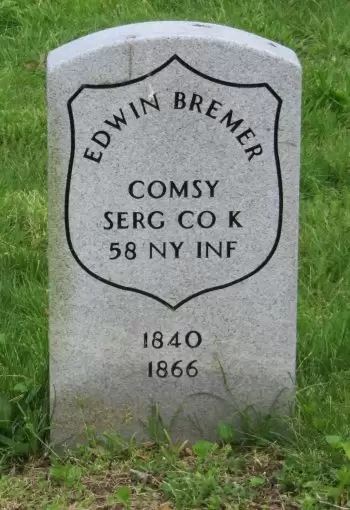
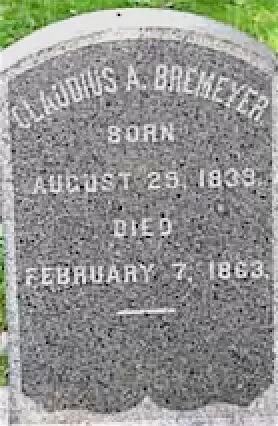
BREMEYER, CLAUDIUS H. A. (1838-1863). Corporal, 67th New York Infantry, Company A. After enlisting at Brooklyn as a private on May 14, 1861, he mustered into the 67th New York on June 20, and was promoted to corporal on November 1 of that year. After being discharged for disability on February 7, 1863, at White Oak Swamp, Virginia, he died of chronic diarrhea at the hospital there. Section 189, lot 16884.
BRENDEL, GEORGE (1833-1874). Private, 55th New York Infantry, Company H. German by birth, Brendel enlisted as a private at Meridian Hill in Washington, D.C., on September 11, 1861. Six days later, he mustered into the 55th New York from which he deserted on March 22, 1862. His last residence was 90 Hester Street in Manhattan. Brendel’s cause of death was meningitis. Section 86, lot 2857, grave 31.
BRENGAL, GEORGE (1835-1866). Private, 11th New York Infantry, Company I. A native of Bavaria, he enlisted at New York City as a private on April 20, 1861. He mustered into Company I of the 11th New York on May 7 and deserted on September 19. Brengal last lived at 71 Suffolk Street, New York City, where his death was attributed to debility. Section B, lot 11005, grave 351.
BRENTON, FRANCIS JOHN (1824-1866). Acting ensign, United States Navy. Originally from Maryland, records show that he was born either in 1824 or 1826. According to census records, he was serving in the Navy in 1860. He was appointed acting ensign on August 30, 1862, served on the USS Isaac Smith, and was taken as a prisoner of war on January 30, 1863, when the Isaac Smith was captured on the Stone River outside of Charleston, South Carolina. After his parole on May 15 of that year, Brenton then served on the Adela as of June 13, the Courier as of June 30 and then was engaged in the West Gulf Blockading Squadron.
Brenton resigned on June 6, 1865, but later was aboard the USS Jasmine in the Gulf of Mexico. His wife’s petition for a pension includes a colleague’s written statement that Benton suffered from the effects of a cold while aboard that vessel and his illness was exacerbated during picket duty. In 1890, an article in The New York Times recounted how artifacts from the Isaac Smith were returned to the Committee on Antiquities of the Grand Lodge of Masons in New York City. Among the memorabilia was a Master Mason’s traveling certificate issued to Brenton on October 20, 1854. His gravestone identifies him as a captain although Navy records do not show that he attained that rank. He last lived at 46 Hicks Street in Brooklyn where he died from tuberculosis attributed to exposure during his Naval service. Jane Brenton, who died in 1885, and is buried with him, received a widow’s pension. Section 126, lot 2458, grave 1121.
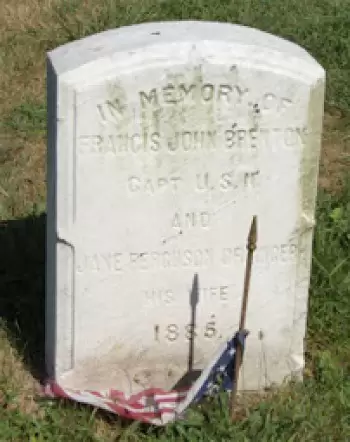
BRESTEL, CHARLES (1823-1906). Major, 7th New York Infantry, Companies K and C. Born in Vienna, Austria, Brestel was an artist and art restorer, 5′ 11″ tall, with fair complexion, blue eyes and brown hair. He enlisted as a first lieutenant at New York City on April 23, 1861, and was commissioned into Company K on that date. On the same date, he received a promotion to the rank of captain and was transferred to Company C. He was wounded in the right shoulder by a musket ball at Malvern Hill, Virginia, on July 1, 1862, sustained a rupture as a result of falling, and was taken as a prisoner of war. He was confined at Richmond, Virginia, on July 5 and paroled at Haxall’s Landing, Virginia, on July 19, 1862.
Brestel commanded the 7th at the Battle of Antietam, Maryland, on September 17, 1862, leading the Second Corps, Richardson’s Division, Caldwell’s Brigade. In his report of that battle three days later, he wrote, “I have the honor to report that the Seventh New York Volunteers on the 17th instant was ordered to take position in the battle-field near Sharpsburg, Md. At about 10 o’clock a.m. the regiment received orders to advance. It drove back the enemy, taking three colors from him. Officers and men behaved bravely. The casualties were 1 commissioned officer and 14 men killed, 1 wounded. Five men are missing…” His actions at Antietam were cited for recognition by his commanding officer Brigadier General John C. Caldwell who wrote on September 27 that Brestel was “cool and brave.” On November 1, 1862, he was promoted to major and transferred to Field and Staff. From December 31, 1862 to February 25, 1863, he was detailed to New York City as a drafting officer, rejoining his regiment on February 28. He mustered out at New York City on May 8, 1863.
In 1873, he applied for and was granted an invalid pension, certificate 127,499, his right hand being crippled by rheumatism contracted during his captivity. He last lived 55 West 12th Street in Manhattan. His death was attributed to heart disease. In 1906, Mathilda Brestel, who is interred with him, applied for and received a widow’s pension, certificate 627,030. Section 142, lot 22120, grave 1.

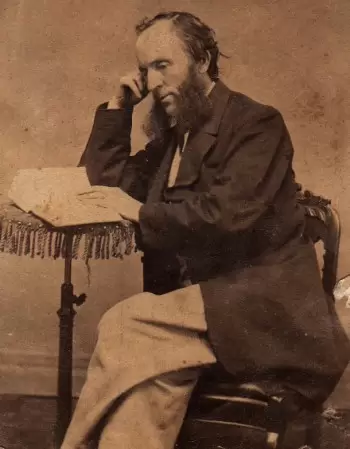
BREVOORT, SAMUEL (1816-1880). Quartermaster, 133rd New York Infantry. Brevoort was born in Cazenovia, New York. Active in politics, he was a Regular Democratic Whig who was elected assemblyman in 1855. On October 12, 1857, an article in The New York Times noted that F. A. Tallmadge, the General Superintendent of the Metropolitan Police, had selected Brevoort as his special aide recognizing his “characteristic zeal and devotion to duty….” Brevoort declined re-nomination to run for the Assembly to accept Tallmadge’s offer. At the time of that appointment, a biography of him stated that he at one time was an apprentice tailor in Waterville, New York. He had also held the position of superintendent of the Crystal Palace, an exhibition center in New York City built for the Exhibition of Industry of All Nations held there starting in 1853 and ending in 1858 when the building burned down.
During the Civil War, Brevoort enlisted as a quartermaster on August 14, 1862, at New York City, and mustered into the 133rd New York on September 24. The 133rd New York, also called the 2nd Metropolitan Guard, was recruited under the auspices of the Metropolitan police. The regiment, part of Banks’s expedition, sailed for New Orleans and took part in the siege of Port Hudson, Louisiana. He was discharged on August 11, 1863.
According to the 1870 census, Brevoort was employed as a notary public; in 1880, his occupation was listed as lawyer. His obituary in the Buffalo Courier indicated that among his lifetime achievements were: the installation of public drinking fountains, a system to light the piers at night, and a design for shields worn by the police. In addition, he was the United States Commissioner to the World’s Fair in London. His last residence was 396 Degraw Street, Brooklyn. Brevoort’s cause of death was marasmus (acute malnutrition). Section 61, lot 3387.
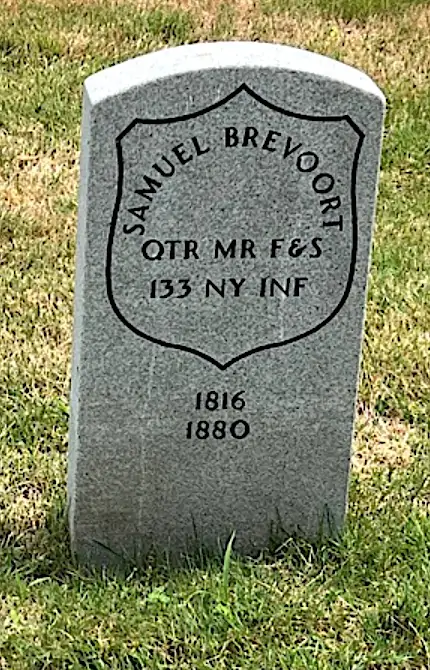
BREWER, HENRY JOHN (1846-1935). Paymaster’s steward, United States Navy. According to his obituary in The New York Times, Brewer, a native of New York City, enlisted in the United States Navy during the Civil War and served with the South Atlantic Blockading Squadron. After entering service in 1863, he was a paymaster’s steward on the USS New Hampshire which was stationed off Port Royal, South Carolina, from 1864-1865.
After being discharged from service in 1866, Brewer worked in a drugstore, then attended Long Island College Hospital from which he obtained his medical degree in 1883. He practiced in Brooklyn for 40 years and was coroner of Brooklyn in 1906. Active in politics, he was the Democratic leader of the 7th Assembly District. He also belonged to the Freemasons, the Winchester Post #197 of the G.A.R., and the Medical Society of Kings County. According to an article in the Brooklyn Daily Eagle, published after his election as one of two Brooklyn coroners, he also belonged to the Royal Arcanum, the Prospect Heights Council and the Monitor Association of Naval Veterans, Port of Brooklyn. In 1909, he applied for and received a pension from the Navy, certificate 45,329. Brewer last lived at 477 14th Street in Brooklyn. He died from heart disease in the Home for Incurables in the Bronx. Section 84, lot 8472.
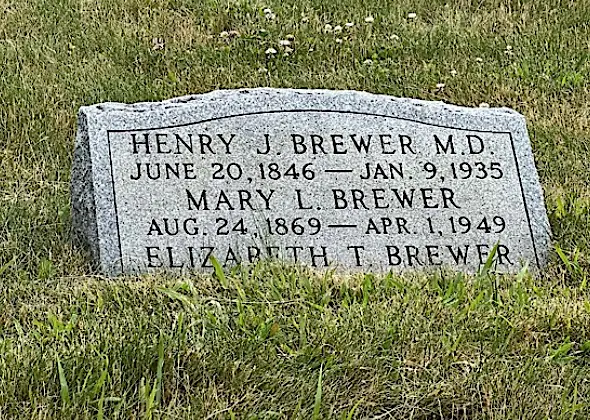
BREWSTER, WILLIAM ROOT (1828-1869). Brigadier general by brevet; colonel, 73rd New York Infantry; major, 28th Regiment, New York State Militia. Born in Goshen, Connecticut, Brewster enlisted at Brooklyn as a major on April 23, 1861, was commissioned into the Field and Staff of the 28th New York State Militia on May 11, and mustered out with his regiment on August 5 at Brooklyn. During the Battle of Bull Run, Virginia, his regiment was assigned to guard the Potomac River and did not see action. After his promotion to colonel on August 19, 1861, following recruiting duty in New York, he was commissioned into the Field and Staff of the 73rd New York Infantry, also known as the Fourth Excelsior, on September 13. The regiment, made up mostly of recruits from the fire departments in New York and Brooklyn, was part of the Peninsula Campaign. He commanded the 73rd at the Battle of Williamsburg, Virginia, on May 5, 1862, which he described in his field report two days later:
Accordingly, I returned to the road, crossed it, and entered the chevaux-de-frise, about 20 paces to the right of the road. We were then ordered to advance across the road which was done in as good order as the obstructions would permit, and immediately upon reaching the left of the road were exposed to a galling fire from the enemy, then rapidly advancing upon that point. I immediately ordered the regiment to commence firing and to advance, which was done, and the enemy, under our steady fire, fell back, and I pushed forward as fast as the nature of the ground, obstructions, &c., would allow, still keeping up a constant fire. At this time the enemy opened upon us with a battery from their fortifications on our left, and commenced a steady fire of shell, having us immediately in their range. I still pressed the regiment forward, thinking that if we could get out of the range they would not fire upon their own friends. It seemed to me at this time as though victory was within our grasp, as they sullenly retired under our fire and theirs slackened very decidedly.
He went on to recall that his lieutenant colonel was taken prisoner when the 73rd was given an order to fall back through a wooded area and that two of his men, Captains Charles B. Elliott (see), of Company I, and Alfred A. Donalds (see), of Company F, were of great assistance to him when the enemy returned fire. Taken prisoner himself at some point, he was returned about August 15, 1862. Subsequently, he led the 73rd at the Battle of Fredericksburg, Virginia, from December 11-15, 1862, and at Gettysburg, Pennsylvania, July 1-3, 1863. His horse was shot out from under him on July 2 and his regiment lost 778 men from 1,837 engaged in that battle. Writing a field report on August 13, 1863, he described the skirmishes of the previous month:
…Seeing the enemy in possession of three of our guns, I made a charge at the head of about 150 men…and succeeded in recapturing them, taking from one the colors of the Eighth Florida Regiment, and bringing in as prisoners the major of that regiment and some 30 of his men.” He led his brigade at the following actions: Mine Run Campaign, Virginia, November 22-December 2, 1863; Wilderness, Virginia, May 5-7, 1864; Spotsylvania Courthouse, Virginia, May 8-21, 1864; Totopotomoy, Virginia, May 27-31, 1864; Cold Harbor, Virginia, May 31-June 2, 1864; and the assault on Petersburg, Virginia, June 15-19, 1864. Subsequently, he commanded the 73rd at the Battle of Strawberry Plains, Virginia, August 14-18, 1864, and the Battle of Poplar Springs Church, Virginia, September 29-October 2, 1864. Brewster mustered out at Petersburg, Virginia, on October 24, 1864. On December 2, 1864, he was brevetted brigadier general of United States Volunteers “for distinguished services in the present campaign before Richmond, Virginia.
A United States Internal Revenue official, Brewster last lived in Brooklyn at 6 Harrison Place where his death was attributed to “softening of the brain.” Members of his regiment and his fellow Freemasons were invited to his funeral according to his obituary in The New York Times. Julia Brewster, who is interred with him, applied for and received a widow’s pension in 1879, certificate 295,990. A monument to the Excelsior Brigade, dedicated on July 2, 1893, stands in the field where it saw action at Gettysburg, and is now known as the Excelsior Field. Section 43, lot 806.
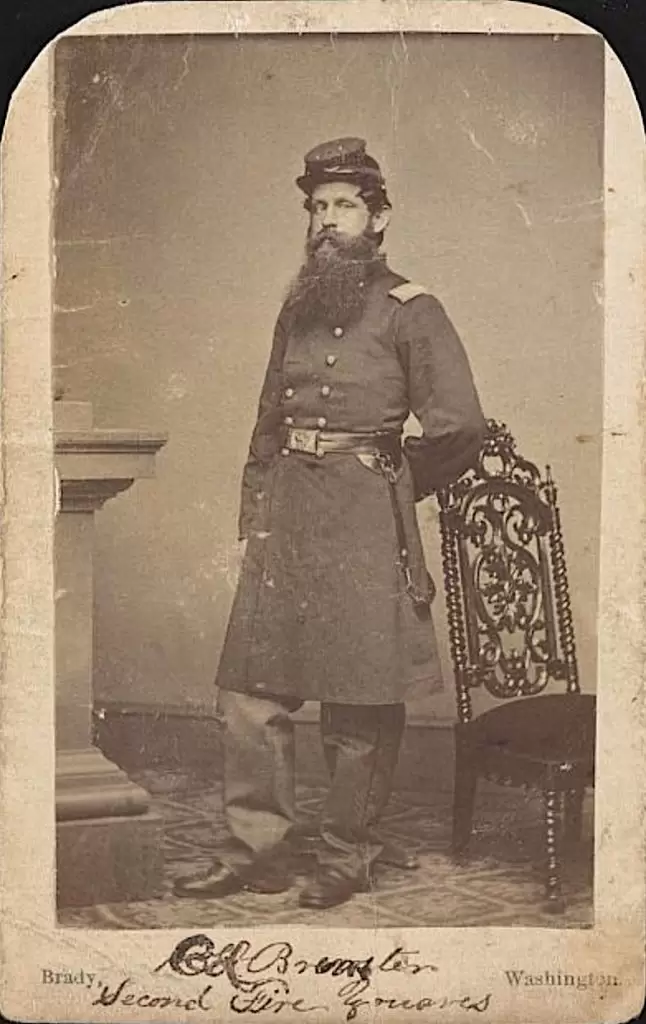
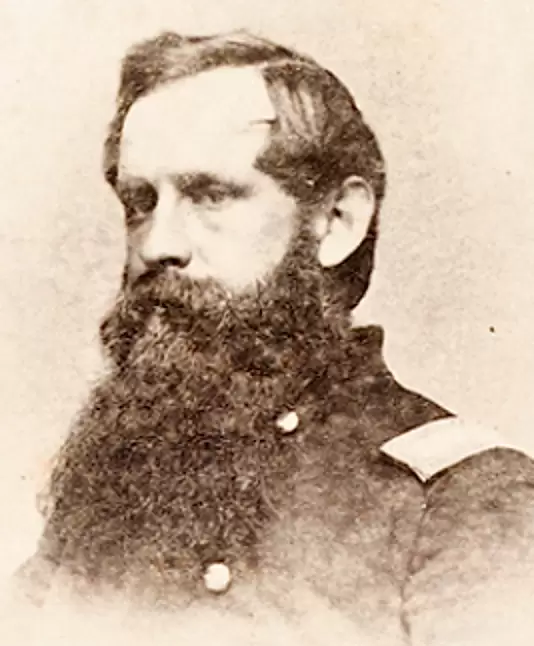
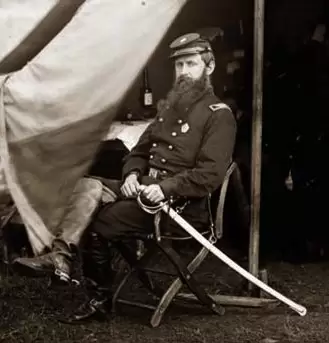
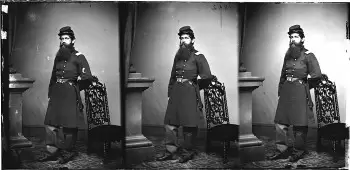
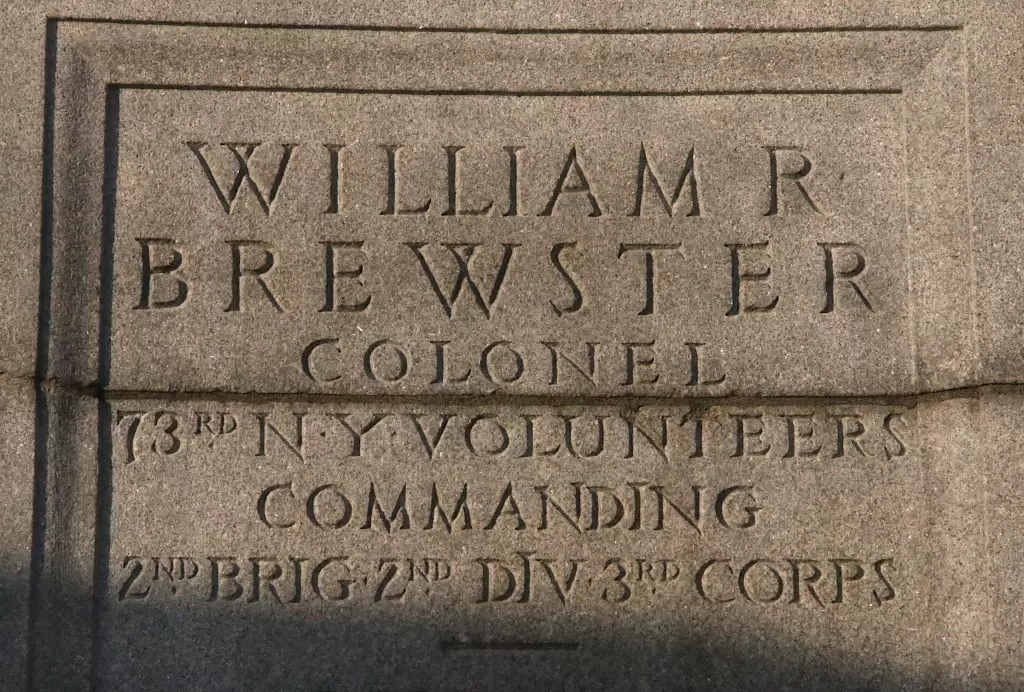
BRIDENBECKER (or BRIDENBAKER), EUGENE (1845-1912). Landsman, United States Navy. Bridenbecker was born in Frankfort, New York. According to the 1860 census, he was living there with his parents, siblings and extended family. As per the records for the Naval Rendezvous, Bridenbecker enlisted on May 10, 1862, at New York City and was discharged ten days later on May 20. He was 5′ 7¼” tall with gray eyes, brown hair and a florid complexion.
The Veterans Census of 1890, which lists him as Eugene Bridenbaker, indicates that he was at the Soldiers’ Home in Kearny, New Jersey. The 1900 and 1910 censuses report that he was living in Newark, New Jersey; he was employed as a machinist at a lock washer company. Section 91, lot 2606.
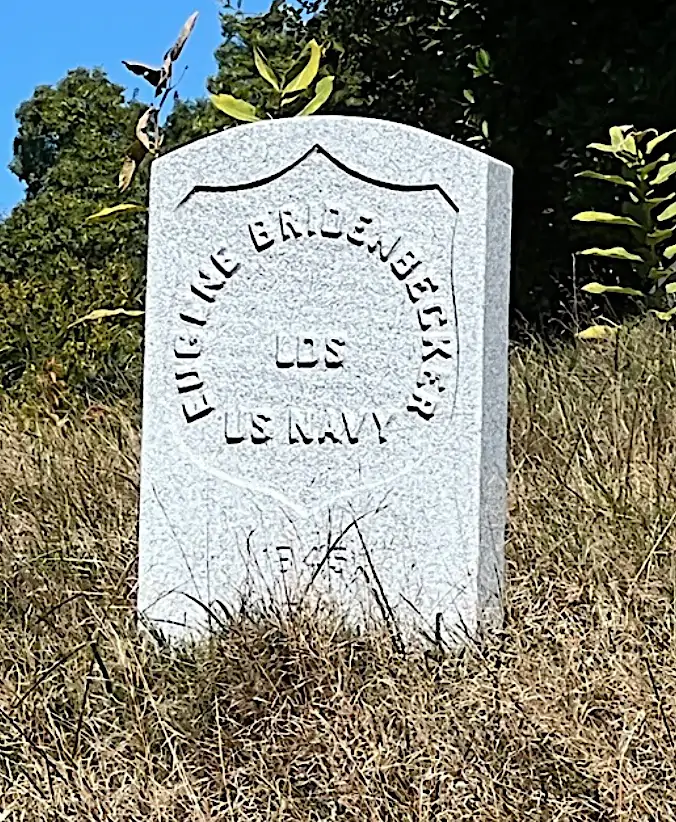
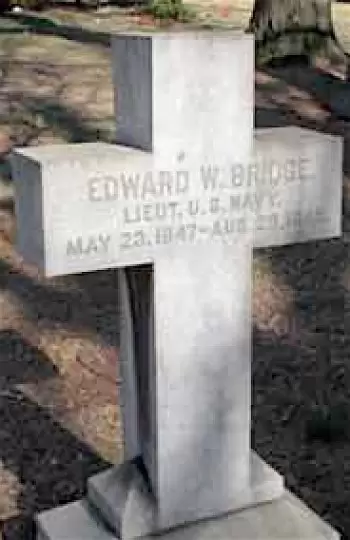
BRIDGE, EDWARD W. (1847-1889). Acting midshipman, United States Navy. Bridge, who was born in New York, entered the Naval Academy in 1863, graduating June 6, 1867. He was an acting midshipman as of September 21, 1863. From July 1, 1867, to January 3, 1868, he was attached to the frigate Minnesota, visiting European ports, the Madeiras, the West Indies and Central America. In January 1868, he was transferred to the Mohican which was attached to the North Pacific Squadron, and became an ensign on December 18, 1868. He then served on the Saranac and Saginaw until 1869. From September 1869 to October 1870, he was attached to the Frolic of the North Atlantic squadron. On March 21, 1870, he was promoted to the rank of master and stationed in the Ordinance Department at the Brooklyn Navy Yard from January 1871 to January 1872. He was promoted to lieutenant on March 21, 1871, and went with the Nantasket to the West Indies where he remained until July 1873, when he again became attached to the Frolic. Subsequently, he was attached to the South Atlantic Squadron, the Gosport Navy Yard in Virginia, and the League Island Navy Yard in San Francisco, California. Bridge retired in June 1887. His last residence was in Saddle River, New Jersey. He died from ulceration of the stomach. Section 53, lot 6327.
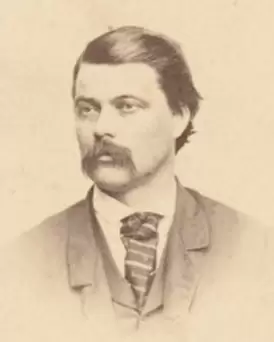
BRIDGFORD, DAVID B. (1831-1888). Major, 1st Battalion Virginia Infantry, Company B, Confederate States of America. Born in Toronto, Canada, and the son of a British Army officer, Bridgford was a shipbroker and commission merchant in Richmond, Virginia, and New York City before the War. He began his military service in the Confederate Army when he enlisted at Richmond as a captain in the 1st Virginia Regulars (also known as the Irish Battalion), Company B, on April 15, 1861, and was immediately commissioned as a captain and commissary officer. The regiment, organized in May 1861, with five companies, served as provost guard in the Army of Northern Virginia. He was listed as absent and sick on September 15 of that year and returned on November 15. He was furloughed on January 12, 1862, for 40 days, was reported sick on March 15, and returned to service on July 1.
After a promotion to major on October 11, 1862, he later served as chief provost marshal to Major General Thomas J. (Stonewall) Jackson for the Second Corps, Army of Northern Virginia, as of January 15, 1863. After Jackson’s death in May 1863, Bridgford wrote, “I was then ordered to report to General R. E. Lee and have since that time filled the position of acting provost marshal, Army of Northern Virginia,” and was listed as detached to that position on the muster rolls of September and October 1864. He surrendered on April 9, 1865, at Appomattox Court House, Virginia. After the surrender, Bridgford issued and signed papers allowing a Confederate “to go into his house, and there remain undisturbed.”
Post-war, he resumed his business in New York City on May 4, 1865, was listed as a broker in the 1884 New York City Directory, and was involved in the Cuban Revolution. Bridgford last lived at 231 East 31st Street in Manhattan. His death was attributed to meningitis. Section 4, lot 21072, grave 361.
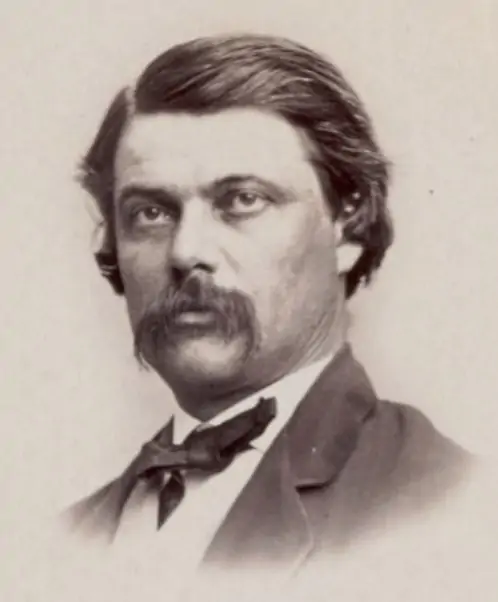
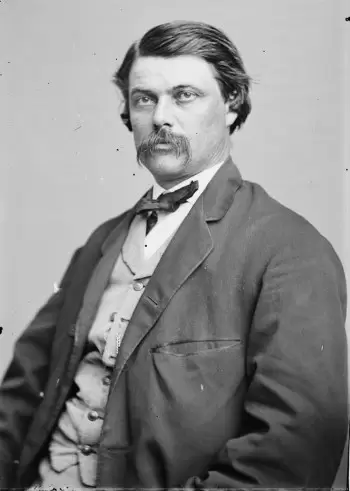
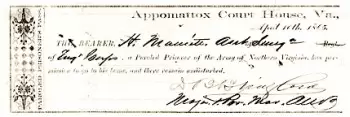
BRIEN, JOSEPH (1837-1865). Private, 42nd New York Infantry, Company D. Brien, who was born in Ireland, enlisted as a private on May 22, 1861, at New York City, and mustered into the 42nd on June 22. He was severely wounded in the left forearm at the Battle of Antietam, Maryland, on September 17, 1862, an injury that necessitated amputation of that limb. He was discharged for wounds on November 14, 1862, at New York City. His last residence was 157 East 11th Street in Manhattan. Section 157, lot 15794.
BRIGGS, CHARLES AUGUSTUS (1841-1913). Presbyterian clergyman and theological professor; private, 7th Regiment, New York State Militia, Company A. Originally interred at Green-Wood, his remains were removed to Chatham, Massachusetts, in 1929. Born in New York City into the family of a prosperous businessman, he attended the University of Virginia. When the Civil War began, he served for 30 days with the 7th Regiment of the New York State Militia in 1861, then entered the Union Theological Seminary.
Briggs studied theology for four years in Berlin, became pastor of the Presbyterian Church in Roselle, New Jersey, and taught Hebrew at the Union Theological Seminary. He was tried for heresy by the Presbyterian Church in 1892. Though the presbytery acquitted him, he was found guilty by the General Assembly and suspended. As a result of this verdict, the Seminary severed its affiliation with the Assembly, and became undenominational within a few years. He was a prolific writer, authoring over 200 books and articles.
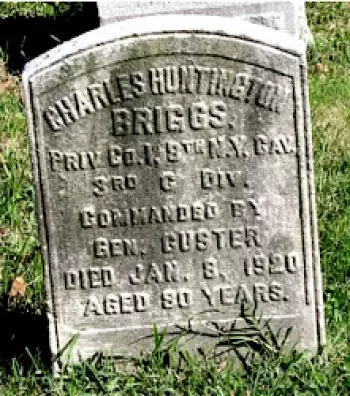
BRIGGS, CHARLES HUNTINGTON (1840-1920). Private, 8th New York Cavalry, Companies I and E. Briggs, a New Hampshire native, enlisted at Edmeston, New York, and mustered into Company I of the 8th New York Cavalry on August 9, 1864. He was transferred intra-regimentally to Company E on November 1, 1864, and mustered out on June 27, 1865, at Alexandria, Virginia. It appears that he also served in the 2nd U.S. Cavalry after the War; pension index cards note his service in that unit, and his gravestone notes that he was commanded by General George Armstrong Custer.
In civilian life, Briggs was a clerk and employed at the post office according to the censuses of 1900, 1910, and 1920. In 1904, he received a pension, certificate 1,085,863. He last lived at 257 Steuben Street in Brooklyn. Briggs died from a stroke. Eliza Maria Briggs applied for a widow’s pension in 1920; it was granted under certificate 889,693. Section 189, lot 18245.
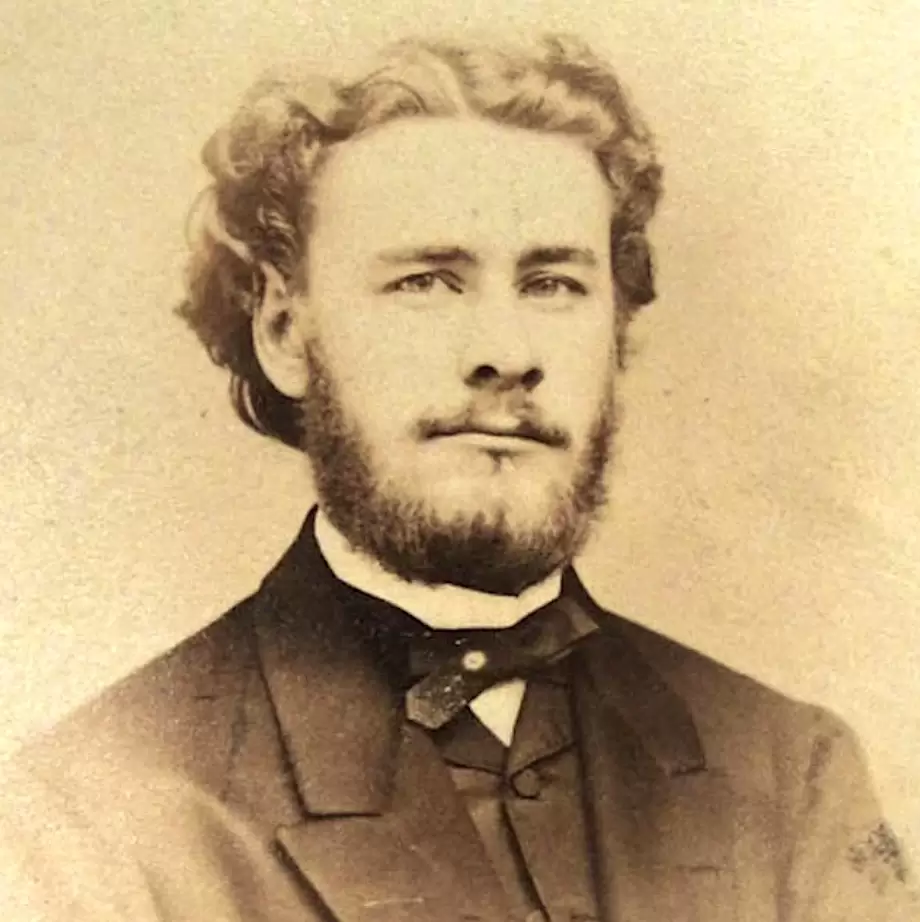
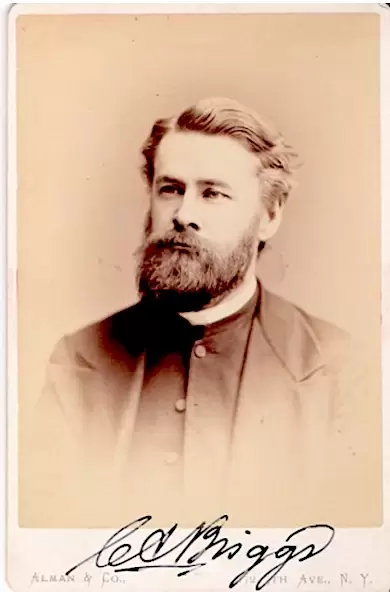
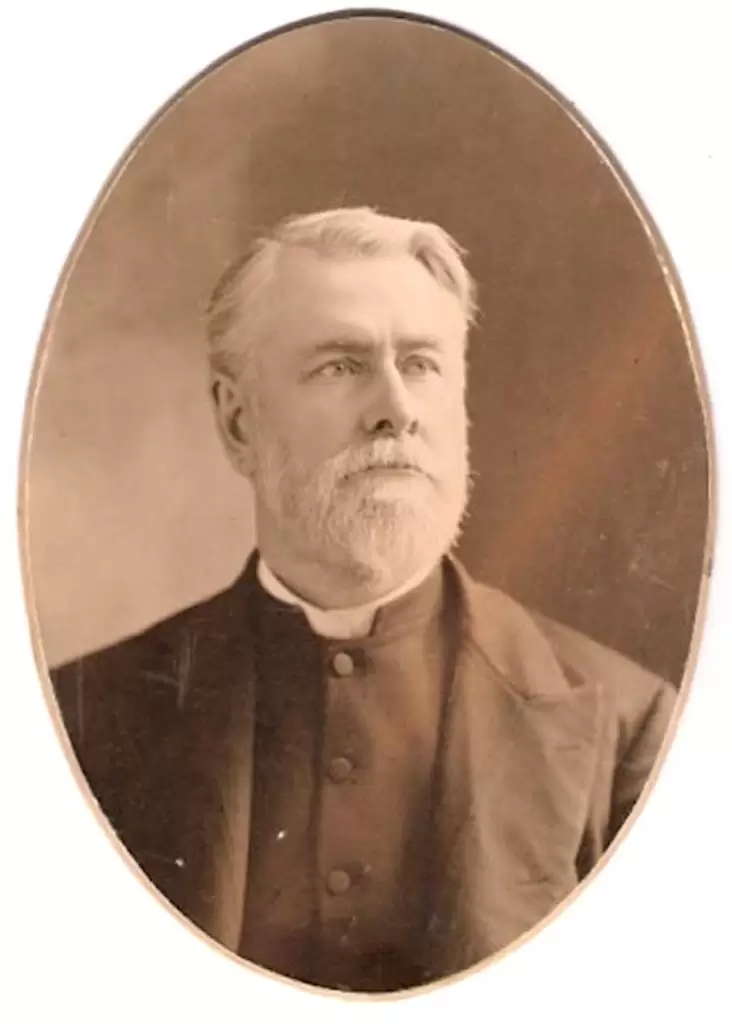
BRIGGS, JR., LUTHER JENNY (1845-1904). Private, 23rd Regiment, New York State National Guard, Company E. Born in New Bedford, Massachusetts, Briggs enlisted at Brooklyn in June 1863 and served for 30 days with the 23rd Regiment from June 16 through July 22. According to a descendant, the 23rd was raised to respond to a threat that Confederate troops were closing in on Gettysburg, Pennsylvania. A written record of the regiment’s activity noted that the soldiers marched down to Fulton Ferry in Brooklyn to the cheers of crowds and carrying rations that would last for two days. They were transported to Philadelphia by train from Perth Amboy, New Jersey, and spent most of their time on picket duty or scouting outside Gettysburg. The regiment returned to New York City by train and steamboat traversing Maryland and New Jersey.
After the war, Briggs was a bookkeeper, lived initially in East Orange, New Jersey, and then moved back to Brooklyn. The Brooklyn Directory for 1867-1870 and the Brooklyn Directory for 1873-1876 list him as a bookkeeper. In 1886, his family moved back to New Jersey. While living in Brooklyn, he was active in the YMCA, the Young Men’s Republican Club and was vice president of the Excelsior Club, a baseball organization. He last lived at 212 5th Street in Union County, New Jersey, where he died from diabetes. As per his obituary in the New York Herald, newspapers in New Bedford, Massachusetts, were asked to print a notice of his death. Section 51, lot 9939.
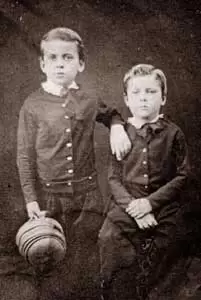

BRIGGS, PHILIP H. (1834-1914). Captain, 13th Regiment, New York State Militia, Engineers and Company E. After Briggs enlisted as a sergeant at Brooklyn on April 23, 1861, he mustered into the 13th Regiment Engineers on May 17, and mustered out on August 6 of that year at Brooklyn. When the 13th Regiment was reactivated a year later, he was promoted to captain on May 28, 1862, and commissioned that day into Company E of his regiment (Heavy Artillery), and mustered out three months later on September 12 at Brooklyn. The 13th National Guard was called up in 1863 and Briggs was again commissioned into the same company and regiment on July 21, 1863, and served as its captain for 30 days. The date his commission took place in 1863 was the same date that his company mustered out at Brooklyn.
In 1904, his application for an invalid pension was granted, certificate 1,100,522. Briggs last resided at 745 Classon Avenue in Brooklyn. His death was attributed to heart disease. Section 164, lot 17573.
BRINCKERHOFF, DANIEL D. (1839-1924). Corporal, 5th New York Infantry, Company C; private, 16th New York Heavy Artillery. Born in Peekskill, New York, he was a resident of Poughkeepsie, New York, when he enlisted at New York City as a corporal on April 25, 1861. On May 9, he mustered into the 5th New York and was discharged on September 13, 1861, at Baltimore, Maryland, for wounds sustained at Big Bethel, Virginia, on June 10, 1861. He re-enlisted as a private at Poughkeepsie on July 25, 1864, and mustered into an unassigned company of the 16th New York Heavy Artillery. On May 7, 1865, he mustered out at Hart’s Island, New York Harbor.
After the war, Brinckerhoff was an active member of the Fifth Veterans Association and became a wealthy cracker baker. The 1875-1876 and the 1877 New York City Directories list him in the cracker business at 220 Grand and 88 Elizabeth Streets in Manhattan; he is listed as a baker in the 1882-1883 New York City Directory with an additional retail location at 42 Pearl Street.
Brinckerhoff’s many indiscretions with women were aired in the press. An article in the New York Herald in 1906 notes that he was sued by Arthur L. Kugel for $50,000, and charged with alienating the affections of Mr. Kugel’s wife. At that time, Brinckerhoff was retired and a widower. That article recounts his previous experiences with women that attracted considerable interest. In 1892, his alleged infidelity with a “woman with short black hair and large white teeth” was aired in open court during a divorce proceeding initiated by his third wife, Henrietta York, who was the sister of his deceased second wife. (His first wife died shortly after their marriage.) That article noted that Brinckerhoff countersued his ex-wife, whom he married in 1877 when she was 17, and currently lived with another man. Two months later, on May 26, 1892, Brinckerhoff married his fourth wife, Blanche Rafter, 26, who was in charge of the retail bakery at 220 Grand Street. In addition, that article also reports that Brinckerhoff supported another married woman with a young child to whom he gave property and other gifts; that suit, brought by Dike Oviatt for $50,000 in damages in about 1905, was settled out of court.
Brinckerhoff applied for and was granted a pension in 1916, certificate number 1,177,783. He last lived at 468 West 176th Street, in New York City where his death was attributed to heart disease. His widow applied for a pension in 1924, application 1,225,366, but no certificate number is listed. Section 32, lot 18737.
BRINCKERHOFF (or BRINKEROFF), GEORGE S. (or L.) (1834-1865). Captain, 10th New York Cavalry, Company B. Brinckerhoff, who was born in Brooklyn, enlisted on January 30, 1864, as a first lieutenant, and was commissioned into his company that same day. He was promoted to captain on December 24, 1864. He died of apoplexy in Philadelphia, Pennsylvania, on March 10, 1865. Section 97, lot 462.
BRINCKERHOFF (or BRINCKUHOFF), JAMES T. (1845-1922). Private, 83rd New York Infantry, Company D. A New York City native, Brinckerhoff enlisted there as a private on May 27, 1861, mustered into the 83rd New York on that same day, and was discharged for disability on January 17, 1862, at Frederick, Maryland.
In 1883, Brinckerhoff applied for and received an invalid pension, certificate 466,931. He listed his occupation as bookkeeper when he mustered into John A. Dix Post #135 of the G.A.R. As per the 1920 census, he was retired and living at 306 Watchung Avenue in North Plainfield, New Jersey. Brinckerhoff last lived on Watson Avenue in Plainfield, New Jersey. He died from bladder cancer. Section 91, lot 4688.
BRINCKERHOFF (or BRINKERHOFF), WALTER (1839-1905). Private, 83rd New York Infantry, Company I; 2nd Battalion, Veteran Reserve Corps, 36th Company; 6th Independent Battery, New York Light Artillery. Brinckerhoff was born in New York City and was a law student at the time of his enlistment. After enlisting as a private at New York City on July 17, 1861, he mustered immediately into the 83rd New York. As per his muster roll, he had blue eyes, brown hair and a fair complexion. He was wounded on September 17, 1862, at Antietam, Maryland, and transferred into the Veteran Reserve Corps on October 26, 1863. He re-enlisted as a private at Albany, New York, on September 5, 1864, mustered into the 6th New York Light Artillery, and mustered out on June 22, 1865, at Washington, D.C.
As per the census of 1880, he was living in Jersey City and working as a life insurance agent. In 1898, his application for an invalid pension was approved, certificate 963,654. He last lived at 2545 Boulevard in Jersey City, New Jersey. Margaret Brinckerhoff applied for and received a widow’s pension in 1905, certificate 602,805. Section 112, lot 12716.
BRINKWORTH, ENOCH (1826-1867). Private, 2nd New York Heavy Artillery, Company G. Born in England, Brinkworth enlisted at New York City as a private on October 10, 1861, mustered into the 2nd Heavy Artillery five days later, and deserted at Staten Island on October 30. He last lived at 21 Broome Street in Manhattan. The cause of his death was pneumonia. Section 115, lot 11193, grave 175.
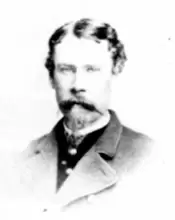
BRISCOE, JOSEPH (or JAMES) CUFFE (1835-1869). Brigadier general by brevet; colonel, 199th Pennsylvania Infantry; 188th Pennsylvania Infantry; major, United States Volunteers Aide-de-Camp; captain, 40th New York Infantry, Companies C, A, and G; first lieutenant, 1st New York Infantry, Companies G, F, B, and E. Born in County Kilkenny, Ireland, he graduated from Trinity College in Dublin as a civil engineer and immigrated to the United States in 1854. Briscoe began his military career when he enlisted as a private at New York City on April 23, 1861, and mustered into Company E of the 1st New York on that date. During the Battle of Big Bethel, Virginia, he carried the regimental colors and was wounded. For his gallantry there, he rose to sergeant on September 1, 1861. He then became a second lieutenant effective upon his transfer to Company B on June 1, 1862. He was promoted to first lieutenant on October 14, 1862, and was transferred on that date to Company F, with an ensuing intra-regimental company transfer to Company G on February 27, 1863.
Briscoe’s construction of a fort at Fair Oaks, Virginia, during the Peninsula Campaign attracted the attention of his superiors, and he was appointed engineer officer of General Kearney’s division. At Germantown, Virginia, he was discharged for promotion on October 31, 1863, and commissioned into the 40th New York Infantry, Company A, as captain on that date. He later transferred to Company G on November 15, 1863, to Company A on April 30, 1864, and to Company C on July 7, 1864. He was discharged for promotion to major and aide-de-camp in the United States Volunteers on September 3, 1864, when he was appointed General David Bell Birney’s chief of staff. Once again on October 3, 1864, he was discharged for promotion and commissioned as colonel of the 199th Pennsylvania Infantry. Given command of the 199th Pennsylvania Volunteers, and promoted to colonel on October 3, 1864, he led his brigade during the capture of Petersburg, Virginia, when they stormed Fort Gregg, where he was wounded on April 2, 1865. For his gallantry there, he was brevetted brigadier general on March 13, 1865. Briscoe was wounded many times during the War, and served in nearly every battle in which the Army of the Potomac engaged. He was transferred to the 188th Pennsylvania Infantry’s Field and Staff on June 28, 1865.
At the close of the Civil War, Briscoe was appointed president of the Examining Board for officers in the general army, with the rank of major. However, he soon was arrested for misconduct during the War. An article in The New York Times of October 5, 1865, described the first day of his court-martial in which Briscoe appeared in court somber and attired in his brevet brigadier general uniform. Briscoe was charged with stealing Confederate notes, gold bullion and coins, worth about $60,000-70,000, from the safe of quartermaster Morris Alberger in Lynchburg, Virginia. Alberger testified that Briscoe devised a carefully thought out plan to take the money while remarking that the money belonged to the United States and that no one would be the wiser if it was missing. Briscoe was dismissed from the service on November 3, 1865, for stealing United States government funds and was officially discharged on December 14, 1865. He last lived at 39 Lafayette Place in New York City. His cause of death was pneumonia. Section 189, lot 18708.
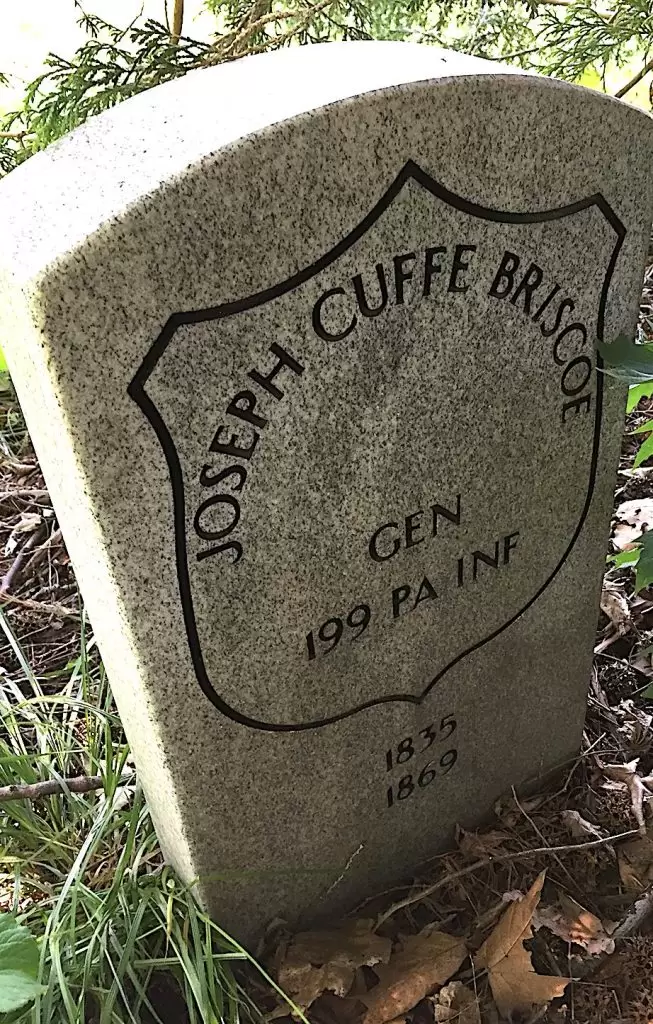
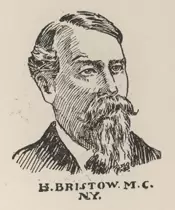
BRISTOW, HENRY (1838-1906). First lieutenant and adjutant, 52nd New York Infantry; private, 7th Regiment, New York State Militia, Company B. Born in St. Michael, in the Azore Islands, he immigrated to Brooklyn with his parents, attended school, and then entered the mercantile industry. During the Civil War, he enlisted as a private in the 7th Regiment, New York State Militia, mustered in on April 26, 1861, and served for 30 days. He returned to the same regiment and company for three months in 1862, when it was part of the New York State National Guard. On October 15, 1862, he was commissioned into the Field and Staff of the 52nd, as first lieutenant and adjutant, and mustered out on December 22, 1862, when that regiment was consolidated with the 175th New York.
Bristow was a member of the Brooklyn Board of Education from 1880-1889, where a school was named for him. In 1896, he was appointed city magistrate. He served as a Republican in Congress from 1901-1903 after being involved in party politics for many years. Appointed public administrator of Brooklyn in 1904, he served in that position until his death. Active in many community organizations, he was a Freemason and member of the Ulysses S. Grant Post #327 of the G.A.R. He received a veteran’s pension and his wife was granted a widow’s pension under certificate 710,895. Bristow last resided at 18 Polhemus Place in Brooklyn. He died from nephritis. Section 148, lot 19908.

BRITTON, GEORGE F. (1823-1901). Captain, 38th New York Infantry, Company G. Born in Rhode Island, he enlisted at New York City as a captain on May 11, 1861, was commissioned into the 38th New York the next month on June 3, and was discharged on August 2.
According to the 1870 census, he was employed as a broker; in 1880, he was practicing law. The Brooklyn Directory for 1880-1882 lists him as a lawyer. His military service was affirmed by the 1890 Veterans’ Schedule. His obituary in the New York Herald referred to him as Captain Britton and noted that his late father, William Britton, also held the rank of captain. He last lived at 1495 Gates Avenue in Brooklyn. His death was attributed to heart disease. Section 79, lot 10717, grave 15.
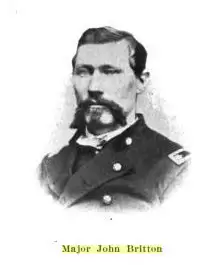
BRITTON, JOHN (1837-1897). Major, 18th Regiment, Pennsylvania Cavalry, Company F. Britton was born in Brownsville, Maryland. After enlisting as a second lieutenant on December 8, 1862, he was immediately commissioned into the 18th Pennsylvania Cavalry, and was promoted to first lieutenant on April 28, 1863. Britton served through 48 battles and received several severe wounds, a saber cut to his head at Hanover, Pennsylvania, on June 30, 1863; a saber cut to the face at Hagerstown, Maryland, on July 6, 1863; and a gunshot wound at Buckland Mills, Virginia, on October 19, 1863. In addition, he had two horses shot under him while in action.
The following is excerpted from a diary entry of the Hanover battle: “…Skirmishing begins and continues more or less till Hanover is reached, when a heavy hand-to-hand cavalry fight ensues in its streets, in which the 18th loses 84 men. Lieut. John Britton and a number of men wounded with sabers….” Britton fought in the battles of Bull Run, Virginia; Gettysburg, Pennsylvania; Fredericksburg, Virginia; and Culpepper, Virginia. He also led one of the divisions in Kilpatrick’s raid on Richmond, Virginia, in February 1864. He was promoted to major on December 3, 1864, at which time he was transferred to the Field and Staff. He mustered out on July 11, 1865, after the promulgation of a special order on July 5. The second saber wound he suffered caused paralysis of the nerves of the eye and the eventual loss of his sight in 1886, and the later loss of his limbs.
For several years following the Civil War, Britton conducted a packing box business in New York. He was a member of the James C. Rice Post #29 of the G.A.R. and belonged to the Old Scottish Athletic Club. In 1873, he filed for an invalid pension that was granted under certificate 127,628. For the last two years of his life, he was unable to leave the house, and his decline was steady until his death. He last lived at 161 East 49th Street in New York City. Frances Anna Britton, who is interred with him, applied for and received a widow’s pension after his death, certificate 459,825. Section 164, lot 15894, grave 4.

BRITTON, JOHN P. (1836-1915). First class boatswain’s mate, United States Navy. Britton, who was born in New York City, enlisted there as a landsman on April 16, 1861. Listing no occupation on the Navy Enlistment Record for the week ending April 20, 1861, he was 5′ 7½” tall, with blue eyes, light hair and light complexion. According to his pension records from the Navy, he served on the USS Perry, Clara Dolsen, and Eastport during the Civil War as a first class boatswain’s mate.
In 1873, Britton was a captain of the hold on the Tigress, a steamer that left from the Brooklyn Navy Yard and ultimately rescued the Polaris, a ship that was stranded off the coast of Newfoundland on an expedition to the North Pole. At the time of his re-enlistment for three years at New York on June 24, 1890, he was a 5’7″ tall mariner with gray hair on a balding head, fair skin and two tattoos, one of a girl and another of a shield of the United States. Britton received a pension from the Navy reflecting both his service in the Civil War and service of about 30 years in the Navy, certificate 24,873. He last lived at 59 East 4th Street in Brooklyn. His death was caused by nephritis. In 1918, his widow was awarded a pension from the Navy, certificate 840,850. Section 126, lot 16874, grave 128.
BROADHURST, WILLIAM HOMER (1843-1921). Rank unknown, 7th Regiment, New York State National Guard, Company C. Broadhurst was born in New York. As per his obituary in the Brooklyn Standard Union, he was a member of the Seventh Regiment Veterans’ Association of the New York State National Guard. Although some details of his service are unknown, he was born in a year that makes it likely that his service was during the Civil War and, as per the Seventh Regiment Gazette, he served in that regiment’s 3rd Company.
As per the census of 1900, Broadhurst was married to Adele Barnes as of 1871, and lived at 294 Lafayette Avenue in Brooklyn with his wife and children. The census of 1910 reports that he had been married for 39 years, lived at 290 Lafayette Avenue and was a wholesale tobacco merchant. The 1915 New York State census notes that he owned a wholesale tobacco business, was a citizen and lived with his wife in Brooklyn.
His death was listed in the Seventh Regiment Gazette. His last residence was 28 Wellington Court in Brooklyn.. He died from heart disease. Funeral services took place at St. James’ Church at St. James Place and Lafayette Avenue. As per New York State Wills and Probate Records for Kings County, Broadhurst had real property worth $14,000 and personal property valued at $10,000 (a combined $347,000 in 20202 money). His wife inherited his residuary estate and his son, William, and daughter, Grace Broadhurst Robinson, were each left $250. Section 60, lot 2964.
BROAS, JAMES H. (1844-1865). Private, 12th Regiment, New York State National Guard, Company A; 22nd Regiment, New York State National Guard, Company E. Broas, who was born in New York, enlisted there and mustered into the 12th New York National Guard on May 31, 1862. He mustered out after three months at New York City on October 8. Subsequently, he served for 30 days in 1863 with the 22nd Regiment, New York National Guard. His last address was 160 East 40th Street in Manhattan. Section 164, lot 15580.
